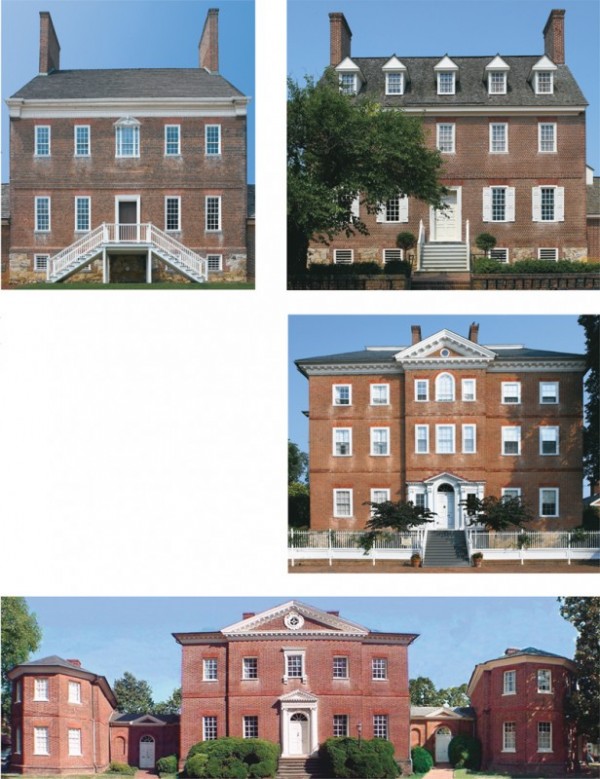
Composite illustration showing, clockwise from top left, four of the most significant houses built during Annapolis’s age of affluence: (a) James Brice House (1767–1773), (b) William Paca House (1763–1775), (c) Chase-Lloyd House (1769–1774), (d) Hammond-Harwood House (ca. 1774). (Photos, Gavin Ashworth.)

Armchair attributed to the shop of John Shaw, Annapolis, Maryland, ca. 1797. Mahogany and lightwood inlay with tulip poplar. H. 37 1/2", W. 21 3/4", D. 19". (Courtesy, Maryland State Archives; photo, Gavin Ashworth.) Several chairs similar to this example have been documented or attributed to Shaw’s shop.
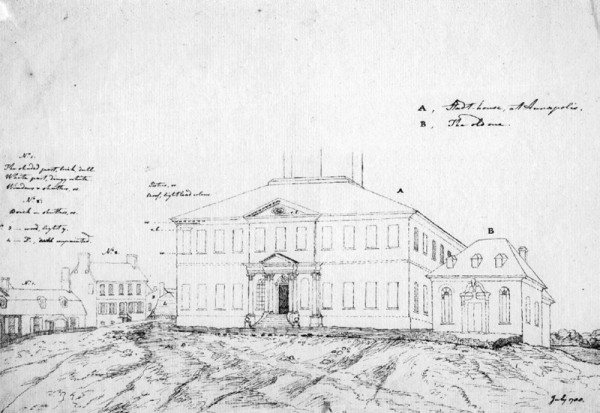
Charles Willson Peale, Front Elevation of the Maryland State House, Annapolis, Maryland, 1788. Pen and ink on paper. 7 3/4" x 11 1/2". (Courtesy, Maryland State Archives, Special Collections, William Voss Elder Collection.)
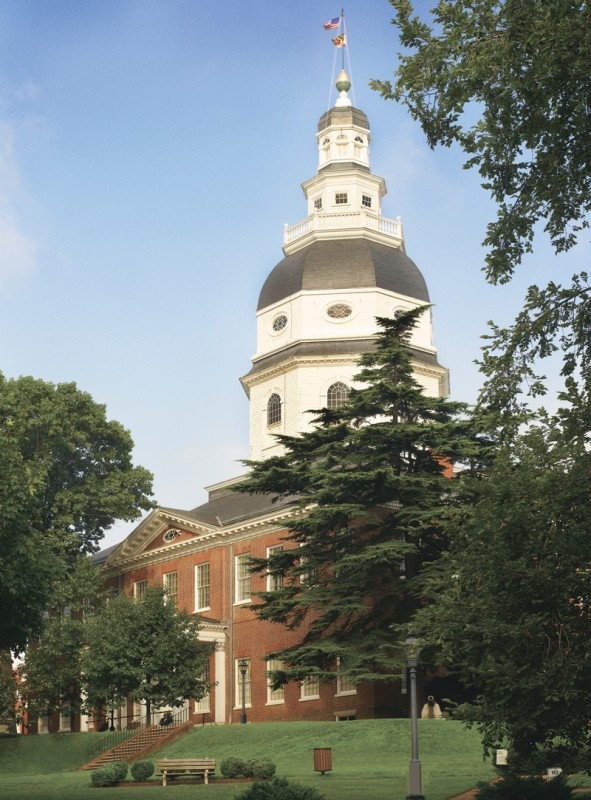
Maryland State House, Annapolis, Maryland, 1772–1779. (Photo, Gavin Ashworth.) This photograph shows the original entrance of the State House. The portico was replaced in 1882, but this was the primary entry for the capitol until the completion of the 1902–1905 annex on the opposite side of the building.
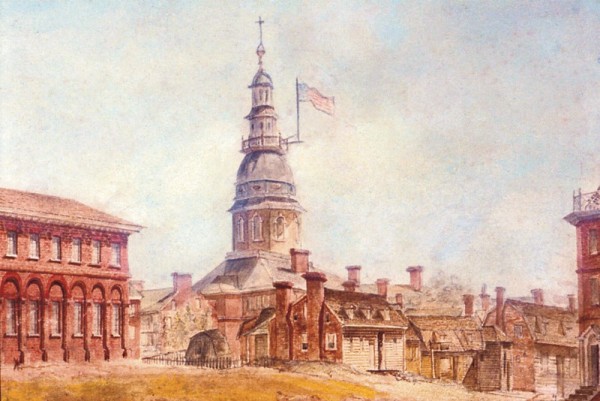
Detail of Charles Cotton Millbourne, View of Annapolis, Maryland, ca. 1794. Watercolor on paper. 10" x 16 5/8". (Courtesy, Hammond-Harwood House Association.) The State House, depicted in the center, dominated a landscape that changed very little in the decades that followed the Revolution. Cabinetmaker John Shaw procured the flag shown on the dome for the 1783–1784 meeting of the Continental Congress in Annapolis.
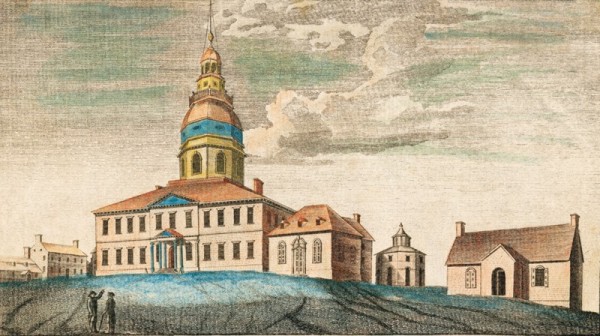
Charles Willson Peale, A Front View of the State-House &c. at ANNAPOLIS the Capital of MARYLAND, ca. 1789. Engraving on paper. 4 3/4" x 6 5/8". (Courtesy, Maryland State Archives, Special Collections, Bond Collection.) This image, which appeared in the Columbian Magazine in February 1789, shows the State House soon after the completion of the dome. Other buildings visible on State House Circle include the home of John Shaw (far left), the council chamber and ballroom (built ca. 1718) (right), the octagonal outdoor privy known as the “public temple,” and the treasury building (built 1735–1736).
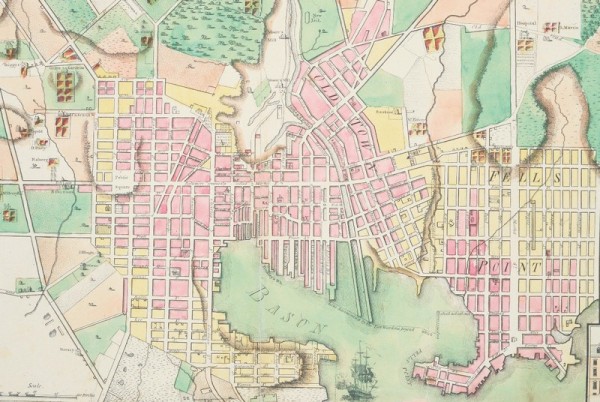
Detail of Warner & Hanna’s Plan of the City and Environs of Baltimore, 1801. Watercolor on paper. 28 1/2" x 20". (Courtesy, George Peabody Library Collection, Johns Hopkins University.) This image shows the extent and potential for Baltimore’s growth at the beginning of the nineteenth century.
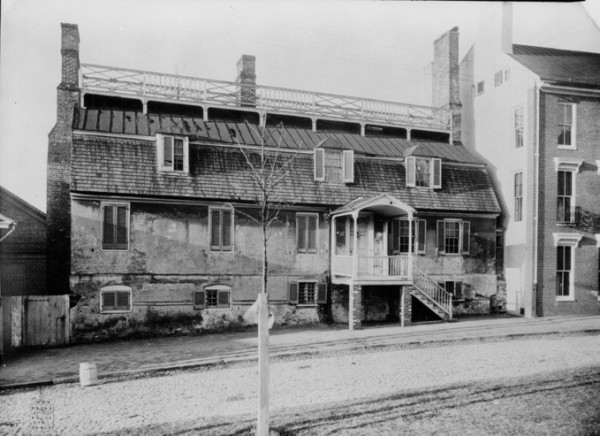
John Shaw House, Annapolis, Maryland, 1720–1725. (Courtesy, Historic American Buildings Survey, Library of Congress.) By the time this photograph was taken (before 1890), Shaw’s house had been enlarged several times. The widow’s walk may have been installed before 1820, and the front porch was probably extended in the beginning of the twentieth century.
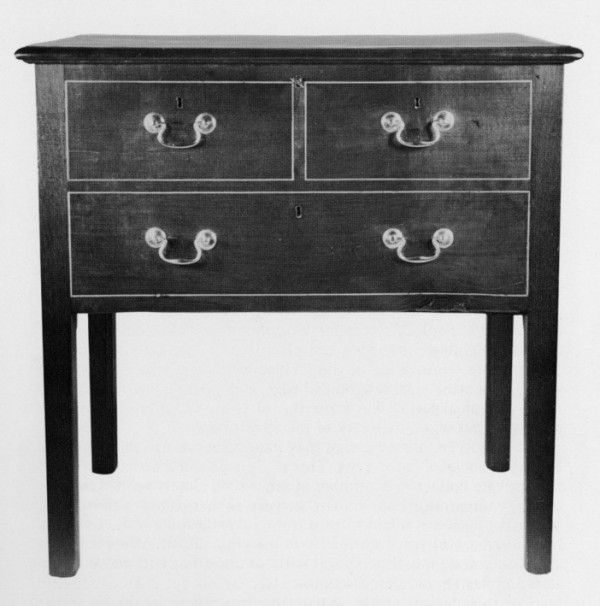
Cellaret probably made by William Tuck in the shop of John Shaw, Annapolis, Maryland, 1795. Mahogany, mahogany veneer, and lightwood inlay with tulip poplar and yellow pine. H. 28 1/4", W. 29 3/4", D. 14 3/4". (William Voss Elder III and Lu Bartlett, John Shaw: Cabinetmaker of Annapolis [Baltimore: Baltimore Museum of Art, 1983], p. 101.)
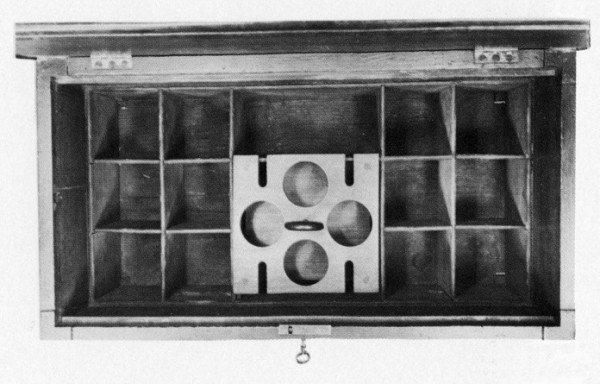
Detail showing the interior of the cellaret illustrated in fig. 9. (William Voss Elder III and Lu Bartlett, John Shaw: Cabinetmaker of Annapolis [Baltimore: Baltimore Museum of Art, 1983], p. 102.)

Cellaret attributed to the shop of John Shaw, Annapolis, Maryland, ca. 1795. Mahogany, mahogany veneer, and lightwood inlay with tulip poplar and yellow pine. H. 28 1/4", W. 29 3/4", D. 14 3/4". (Courtesy, Hammond-Harwood House Association; photo, Gavin Ashworth.) This cellaret is nearly identical to the one illustrated in fig. 9.
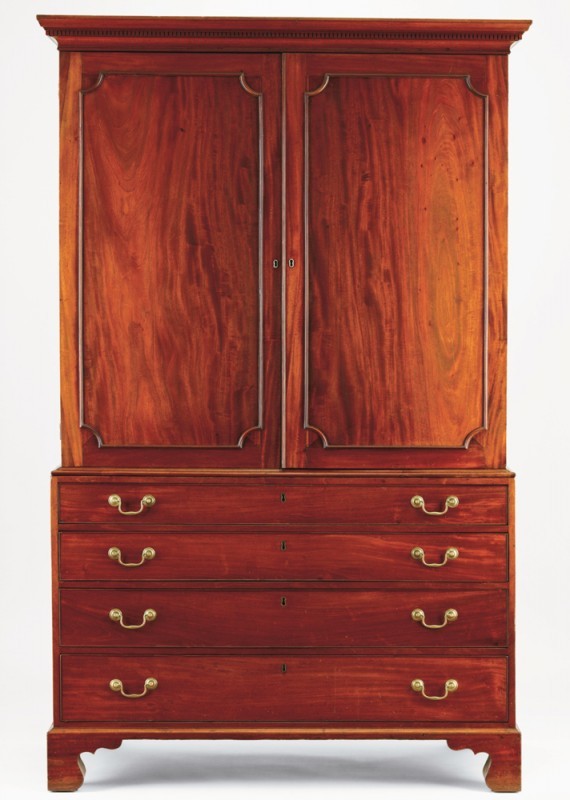
Clothespress probably made by William Tuck in the shop of John Shaw, Annapolis, Maryland, ca. 1795. Mahogany and mahogany veneer with tulip poplar and yellow pine. H. 81 1/2", W. 49 7/8", D. 25". (Courtesy, Maryland Historical Society; photo, Gavin Ashworth.)
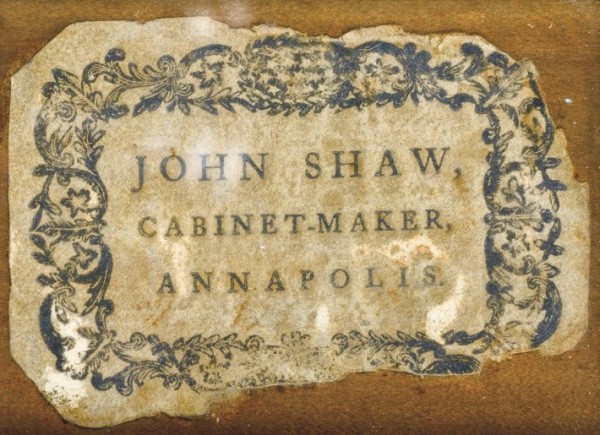
Detail of the label on the clothespress illustrated in fig. 12. (Photo, Gavin Ashworth.)
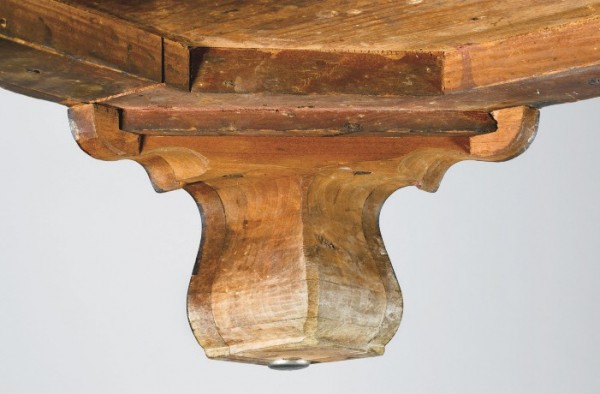
Detail of one of the laminated glue blocks supporting the case and feet of the clothespress illustrated in fig. 12. (Photo, Gavin Ashworth.)
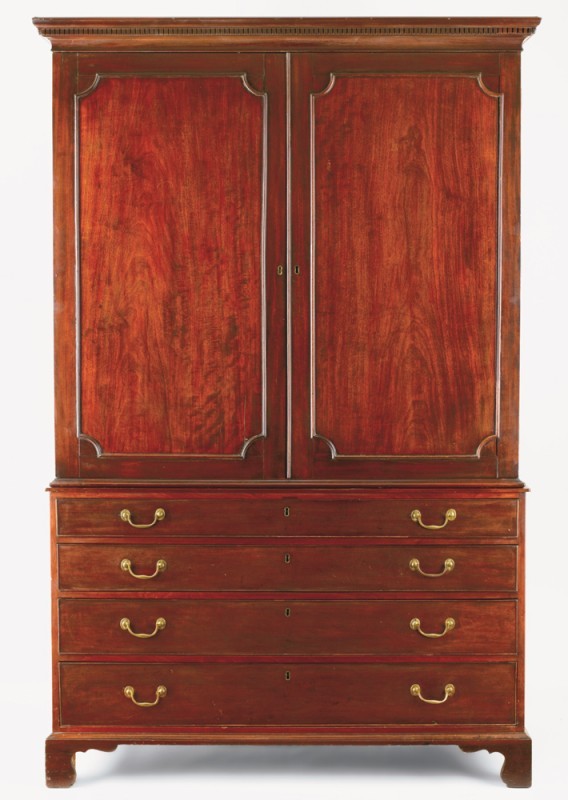
Clothespress probably made by a journeyman whose initials were “JB,” in the shop of John Shaw, Annapolis, Maryland, 1795. Mahogany and mahogany veneer with tulip poplar and yellow pine. H. 80 1/4", W. 51 3/8", D. 24 3/4". (Courtesy, Hammond-Harwood House Association; photo, Gavin Ashworth.) The initials on the label may be those of John Walter Battee, “aged eighteen years the 18th day of November 1793,” who apprenticed to John Shaw on November 5, 1793, to “learn the . . . business of Cabinet Maker & Joiner to serve until he be of Age of which will happen on the eighteenth Day of November 1796” (Anne Arundel County Register of Wills, Orphans Court Proceedings, liber JG1, February 14, 1794, fols. 415–16, MSA C 125-4). The initials and date on the label correspond with Battee’s tenure with Shaw, and he may also be responsible for the “J 1796 B” on the label on the bureau with secretary drawer illustrated in fig. 25. It is not known whether Battee continued making furniture after concluding his apprenticeship in November 1796.
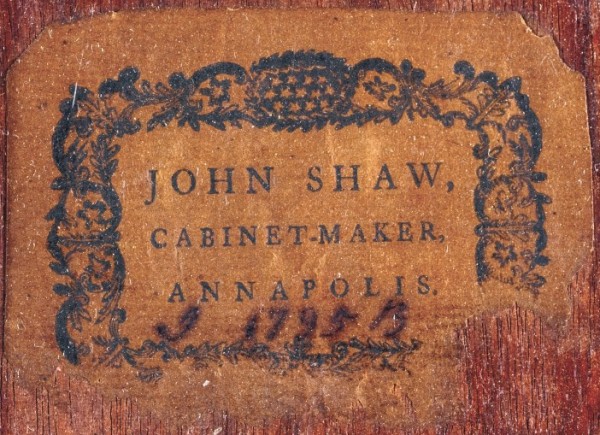
Detail of the label on the clothespress illustrated in fig. 15. (Photo, Gavin Ashworth.)
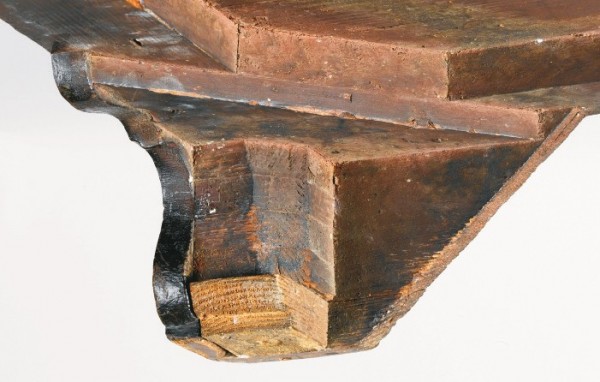
Detail of one of the laminated glue blocks supporting the case and feet of the clothespress illustrated in fig. 15. (Photo, Gavin Ashworth.)

Clothespress probably made by a journeyman whose initials were “JH” in the shop of John Shaw, Annapolis, Maryland, 1797. Mahogany, mahogany veneer, and dark and lightwood inlay with yellow pine. H. 92", W. 51 1/2", D. 25". (Courtesy, Baltimore Museum of Art, Friends of the American Wing Fund, BMA 1976.76.)
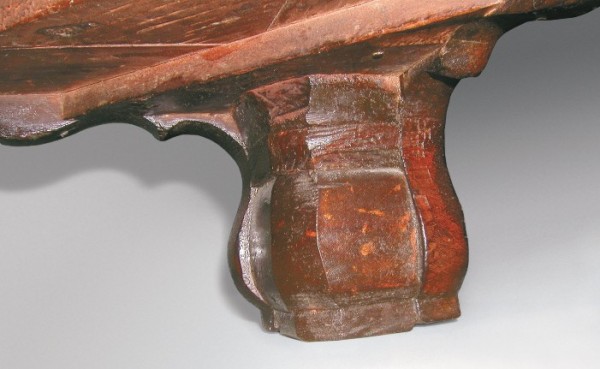
Detail of one of the laminated glue blocks supporting the case and feet of the clothespress illustrated in fig. 18.
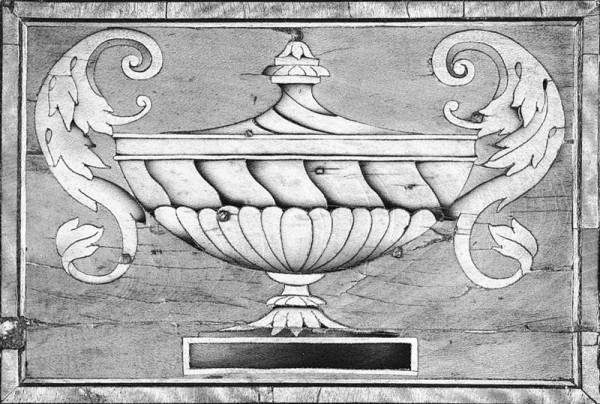
Detail of the urn inlay on the center tablet of the pediment of the clothespress illustrated in fig. 18.
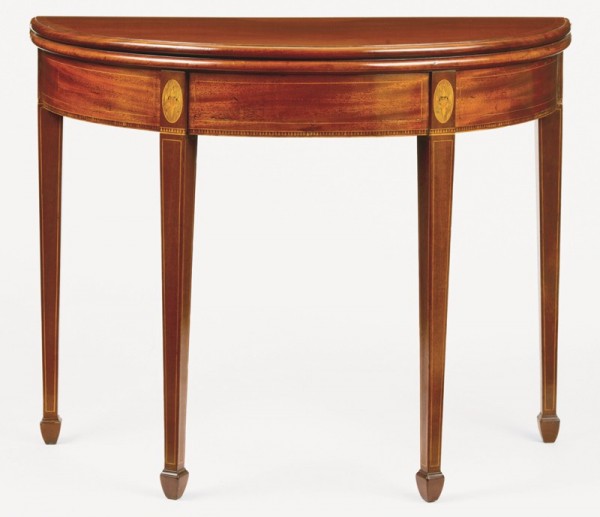
Card table probably made by William Tuck in the shop of John Shaw, Annapolis, Maryland, 1796. Mahogany, mahogany veneer, and dark and lightwood inlay with tulip poplar, yellow pine, and white oak. H. 28 3/4", W. 36", D. 17 3/4" (closed). (Private collection; photo, Gavin Ashworth.)
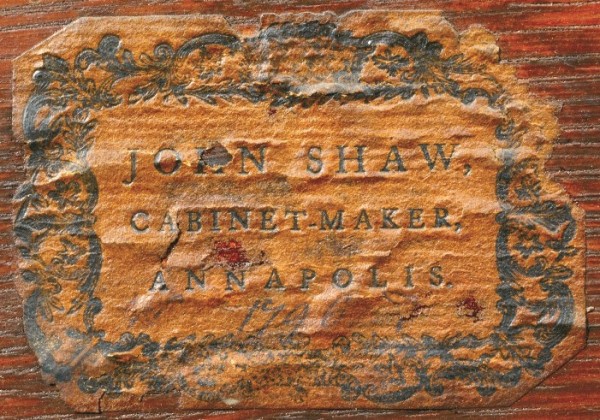
Detail of the label on the card table illustrated in fig. 21. (Photo, Gavin Ashworth.)
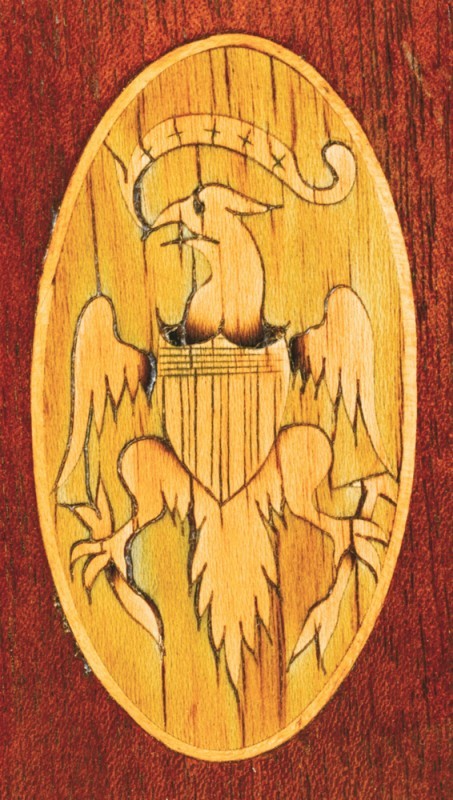
Detail of the inlay on the card table illustrated in fig. 21. (Photo, Gavin Ashworth.)
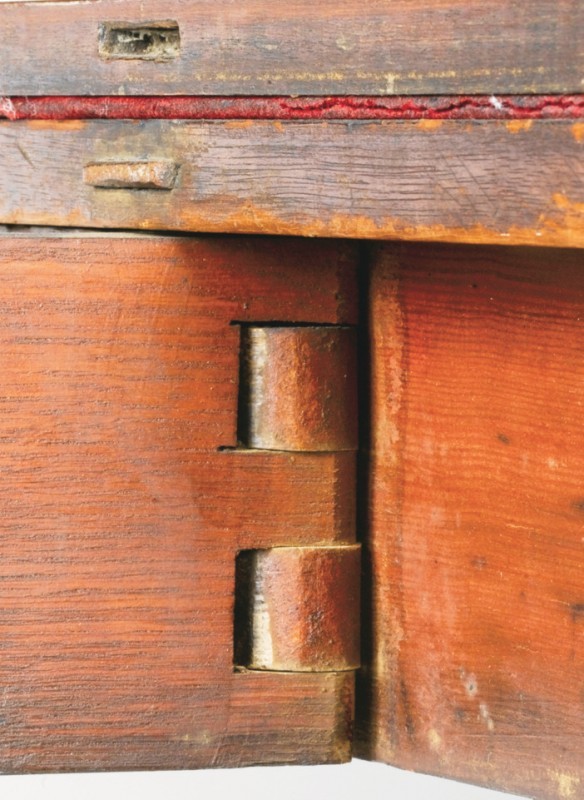
Detail of the fly rail hinge and alignment mortise and tenon on the leaves of the card table illustrated in fig. 21. (Photo, Gavin Ashworth.)
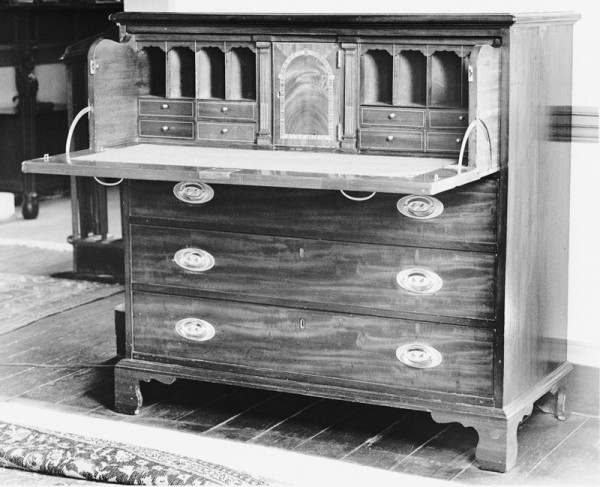
Bureau with secretary drawer probably made by a journeyman whose initials were “JB” in the shop of John Shaw, Annapolis, Maryland, 1796. Mahogany, mahogany veneer and lightwood inlay. H. 43", W. 44 3/4", D. 21 1/2". (Private collection; photo, Museum of Early Southern Decorative Arts, Old Salem Museums & Gardens.) This bureau has vertical back boards that are set in rabbets in the sides and top and secured with nails. The dustboards occupy the full depth of their dadoes and extend all the way to the back of the case. The case and feet are supported by square vertical glue blocks that butt against triangular blocks that fill the space between the bottom of the case and bottom edge of the front and side moldings.
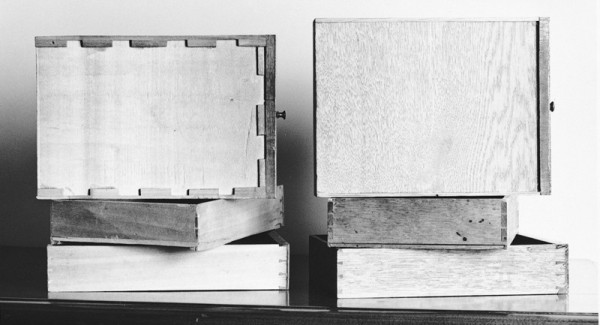
Detail showing the construction of the small drawers in the writing compartment of the bureau illustrated in fig. 25. Different techniques were used in the construction of the drawers indicating that at least two different artisans collaborated in the production of this piece.
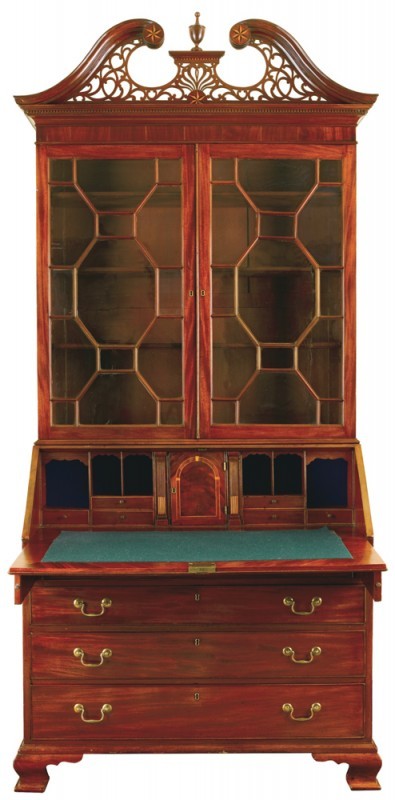
Desk-and-bookcase attributed to the shop of John Shaw, Annapolis, Maryland, ca. 1797. Mahogany, mahogany veneer, and lightwood inlay with tulip poplar and yellow pine. H. 98 1/4", W. 47 3/8", D. 23 1/2". (Courtesy, Hammond-Harwood House Association; photo, Gavin Ashworth.)
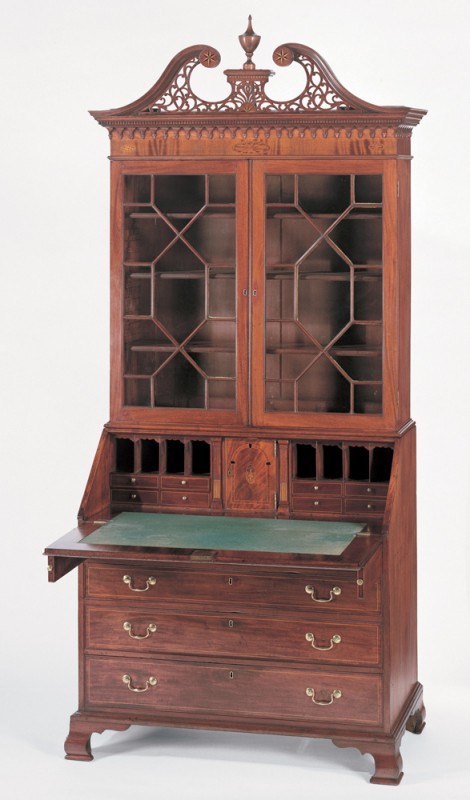
Desk-and-bookcase attributed to the shop of John Shaw, Annapolis, Maryland, ca. 1790–1800. Mahogany, mahogany veneer, and dark and lightwood inlay with tulip poplar and yellow pine. H. 98", W. 46", D. 24". (Courtesy, Museum of Early Southern Decorative Arts, Old Salem Museums & Gardens.)
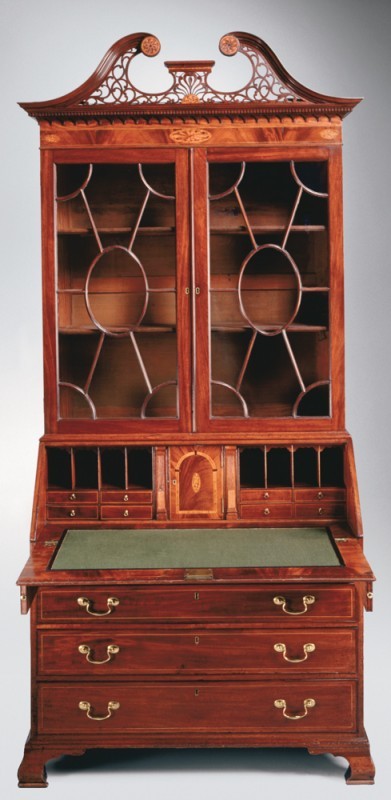
Desk-and-bookcase probably made by William Tuck in the shop of John Shaw, Annapolis, Maryland, 1797. Mahogany, mahogany veneer, and dark and lightwood inlay with tulip poplar, yellow pine, and white oak. H. 98 5/8", W. 45 3/4", D. 22". (Courtesy, White House Historical Association (White House Collection); photo, Bruce White.) The Shaw label on this desk-and-bookcase is inscribed “W 1797 T,” as are the labels on the card table and clothespress illustrated in figs. 12 and 21.
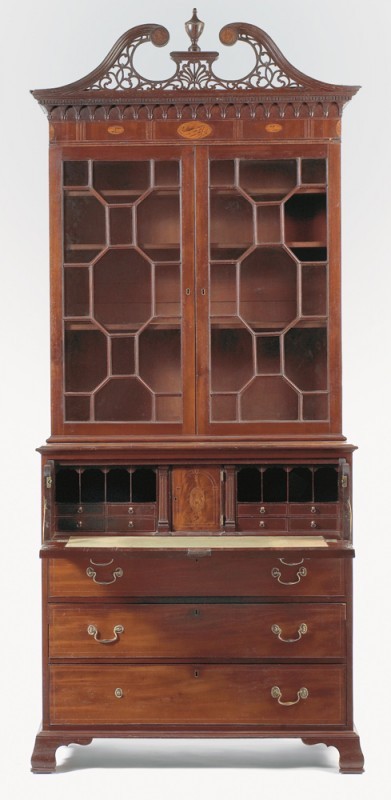
Secretary-and-bookcase probably made by William Tuck in the shop of John Shaw, Annapolis, Maryland, ca. 1797. Mahogany, mahogany veneer, and dark and lightwood inlay with yellow pine and tulip poplar. H. 105", W. 45 1/2", D. 21 5/8". (Courtesy, Christie’s; photo, Ellen McDermont.) The secretary-and-bookcase has an upper case with a four-panel back, a lower case with horizontal backboards that are nailed into rabbets in the top and sides, feet with square, laminated glue blocks, and a red wash or pinking on many of the secondary surfaces.
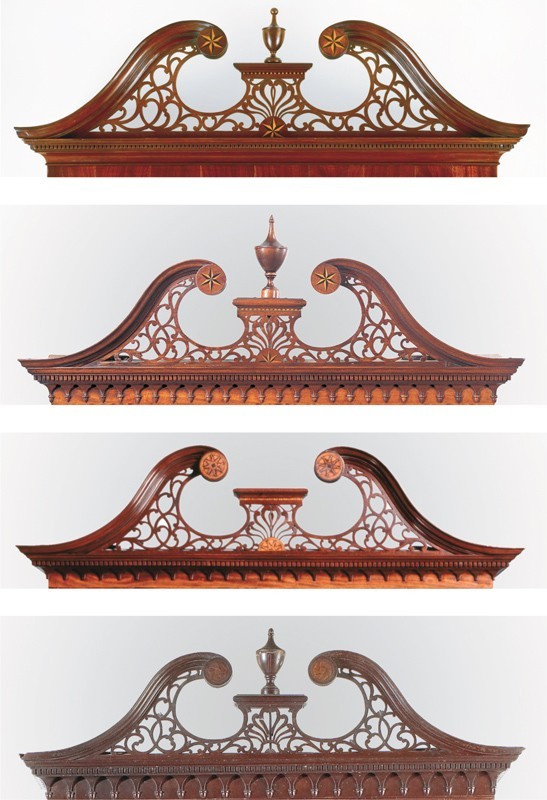
Composite detail showing the pediments of the desk-and-bookcases and secretary-and-bookcase illustrated in (from top to bottom) figs. 27–30. Shaw purchased most of his inlays from Baltimore specialists, including the eagles on the card table illustrated in figs. 21 and 23 and prospect door of the secretary-and-bookcase illustrated in figs. 30 and 33, and much of the other work illustrated in this article. A few inlays, like the urn on the pediment of the press illustrated in figs. 18 and 20, may represent British imports.
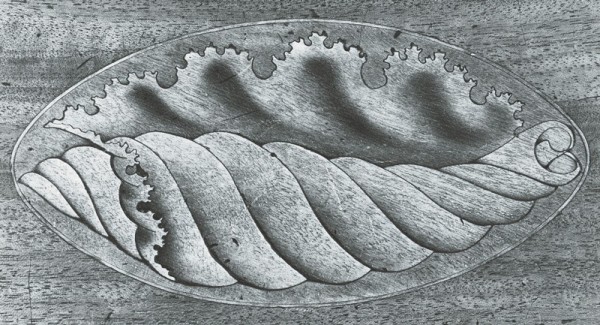
Detail of the inlaid shell on the fallboard of the desk-and-bookcase illustrated in fig. 29.
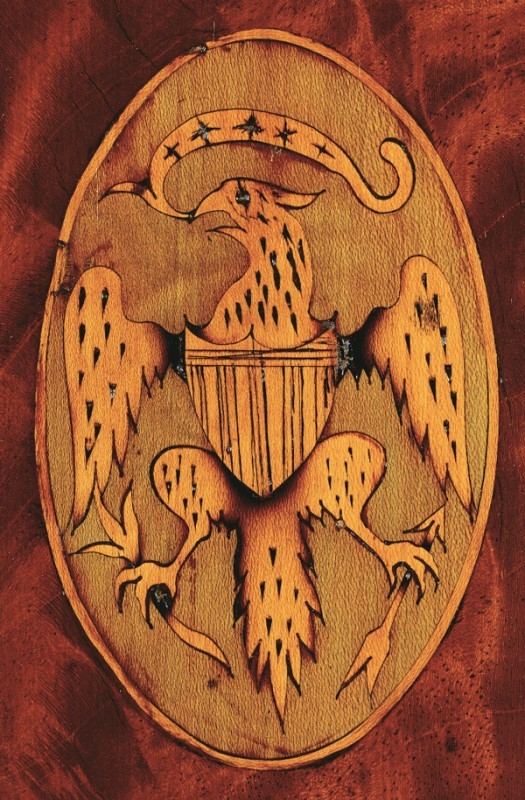
Detail of the eagle inlaid on the prospect door of the secretary-and-bookcase illustrated in fig. 30. (Photo, Gavin Ashworth.)
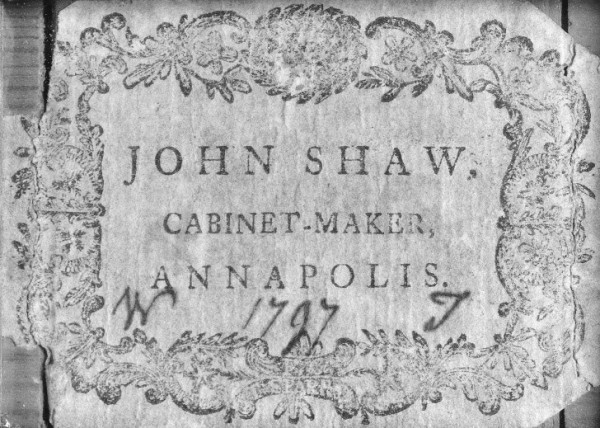
Detail of the label on the desk-and-bookcase illustrated in fig. 29. (Courtesy, White House Historical Association; photo, Bruce White.)

Composite detail showing the front and rear foot blocking and base construction of the desk-and-bookcase illustrated in fig. 29.

Composite detail showing the front and rear foot blocking and base construction of the secretary-and-bookcase illustrated in fig. 30. (Photo, Gavin Ashworth.)
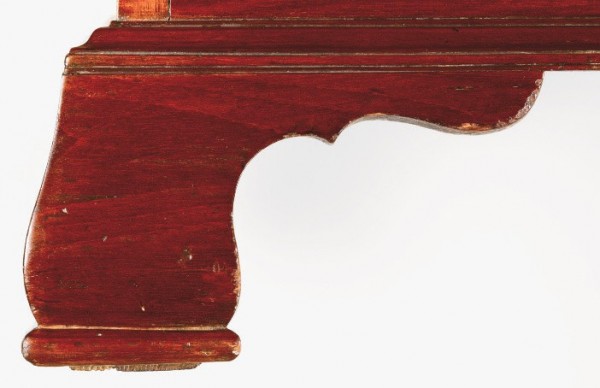
Detail of the left front foot on the secretary-and-bookcase illustrated in fig. 30. (Photo, Gavin Ashworth.)
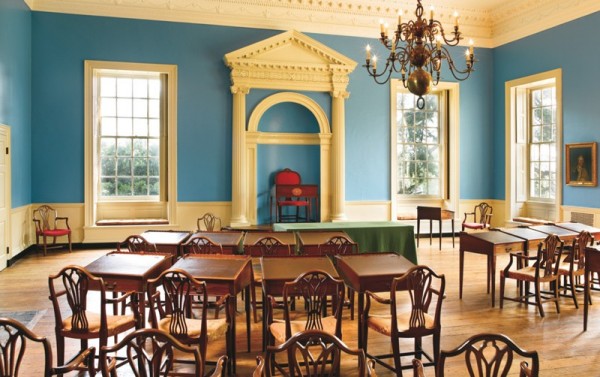
View of the Old Senate Chamber, Maryland State House, Annapolis, Maryland, 1772–1779. (Courtesy, Maryland State Archives; photo, Gavin Ashworth.) This space served as the senate chamber from 1779 until 1906. The illustrated furnishings represent a combination of eighteenth-century objects made in Shaw’s shop and twentieth-century pieces made in the shop of Baltimore cabinetmaker Enrico Liberti.
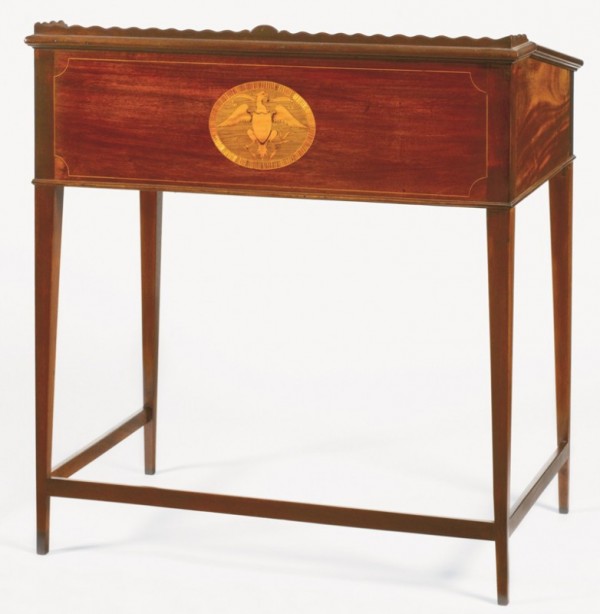
President’s desk probably made by William Tuck in the shop of John Shaw, Annapolis, Maryland, 1797. Mahogany, mahogany veneer, and dark and lightwood inlay with tulip poplar. H. 38", W. 35 1/2", D. 21 1/4". (Courtesy, Maryland State Archives; photo, Gavin Ashworth.)

Detail of the label on the desk illustrated in fig. 39. (Photo, Gavin Ashworth.)
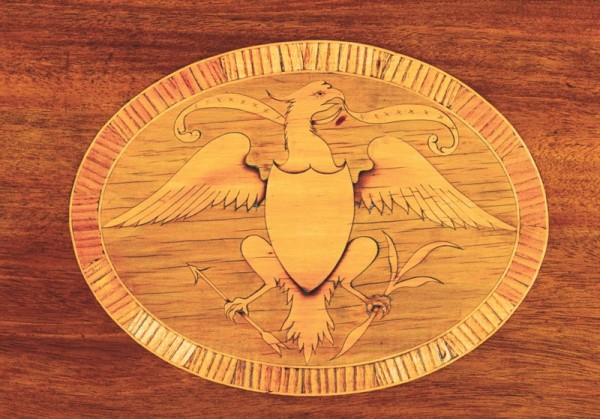
Detail of the inlaid eagle on the desk illustrated in fig. 39. (Photo, Gavin Ashworth.)
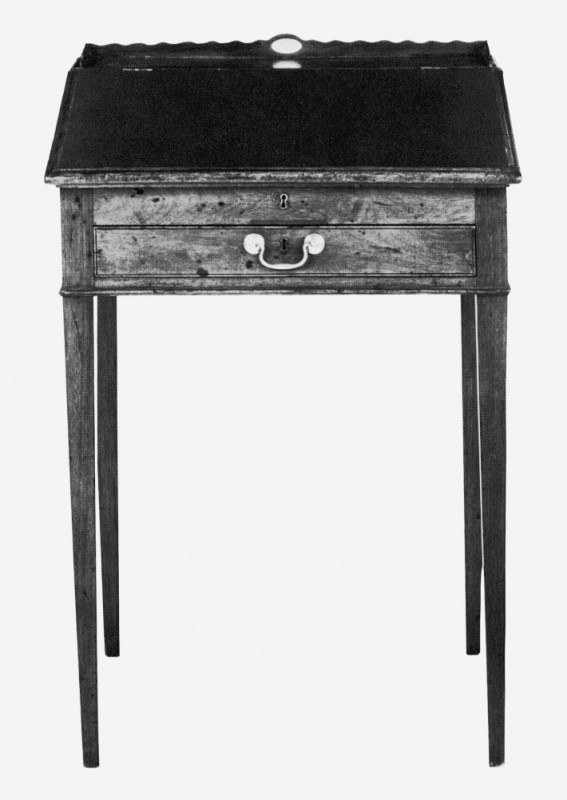
Desk made in the shop of John Shaw, Annapolis, Maryland, ca. 1797. Mahogany, mahogany veneer, and dark and lightwood inlay with tulip poplar and yellow pine. H. 35", W. 24 1/2", D. 21". (Collection of Charles Heyward Meyer; photo, William Voss Elder III and Lu Bartlett, John Shaw: Cabinetmaker of Annapolis [Baltimore: Baltimore Museum of Art, 1983], p. 133.)

Detail of the label on the desk illustrated in fig. 42. The signature on the label reflects the work of Washington Tuck when the desk was repaired in Shaw’s shop in 1801.
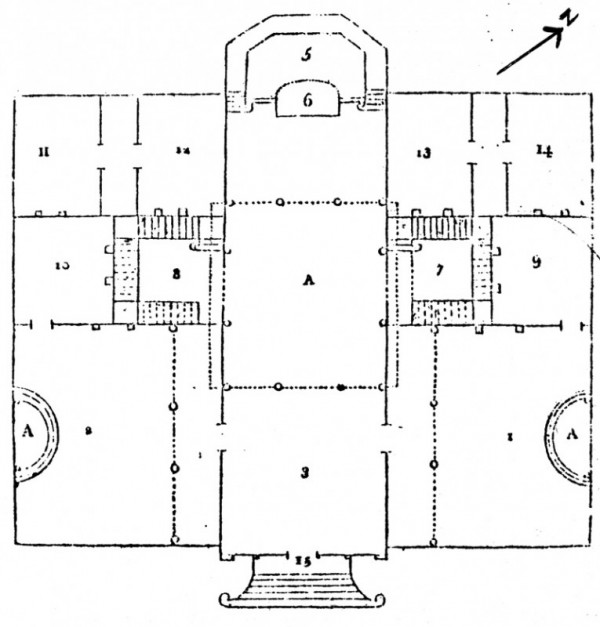
“The Ground Plan of the State-House at Annapolis,” The Columbian Magazine, February 1789. (Courtesy, Maryland State Archives, Special Collections, State House Graphics Collection.) Known as the “Columbian Plan,” this document indicated the position of the senate and house of delegates chambers and committee rooms, the general court (abolished in 1805 and its jurisdiction replaced by the court of appeals), and the record offices of the chancery court, general court, land office, and register of wills on the first floor. Located on the second floor were the council chamber (above the senate chamber), auditor’s chamber (above the house chamber), two jury rooms for the courts, and the repositories for arms above the record offices. The floor plan was classically Georgian, with the senate chamber to the right of the main door and the house of delegates chamber to the left. The two chambers were the same size and mirror images of each other, with raised podiums or “thrones” for the president and the speaker in the center of the rooms, and a visitor’s gallery at the back of each chamber.
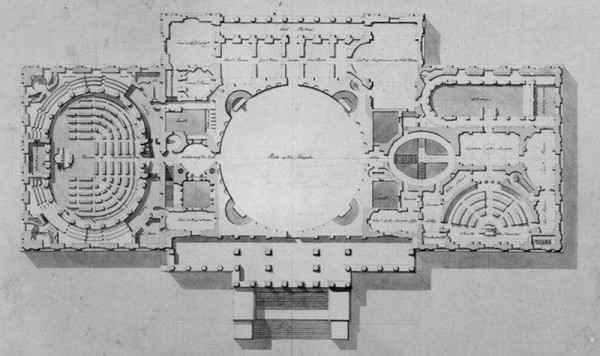
Benjamin Henry Latrobe, “Plan of the Principal Story of the Capitol, U.S.,” Washington, D.C., 1806. Graphite, ink, and watercolor on paper. 19 1/2" x 29 3/4". (Courtesy, Prints and Photographs Division, Library of Congress.) William Tuck likely saw the semicircular, tiered layout of the House of Representatives’ chamber on the left when he visited the Capitol in 1807. Latrobe depicted the furniture in the House chamber as a combination of straight and curved desks.

Speaker’s desk made in the shop of William and Washington Tuck, Annapolis, Maryland, 1807. Mahogany, mahogany veneer, and dark and lightwood inlay with yellow pine. H. 32 3/4", W. 36 1/4", D. 23". (Courtesy, Museum of Fine Arts, Boston, gift of Mr. and Mrs. Robert B. Choate, 63.12, © 2007, Museum of Fine Arts, Boston.)

Front view of the desk illustrated in fig. 46.

Detail of the inlay on the right rear leg of the desk illustrated in fig. 46.

Detail of a wooden knob on the desk illustrated in fig. 46.
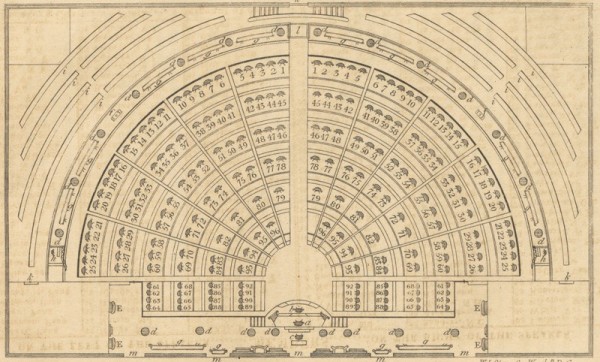
“Hall of the House of Representatives,” from Peter Force, National Calendar, 1823. Dimensions not recorded. (Courtesy, Rare Book and Special Collections Division, Library of Congress.) The furnishing scheme of the house of delegates chamber in Annapolis closely resembled that of the House of Representatives in Washington, D.C., in which straight desks were placed to the sides of the dais, while curved desks were symmetrically arranged in front of the speaker.
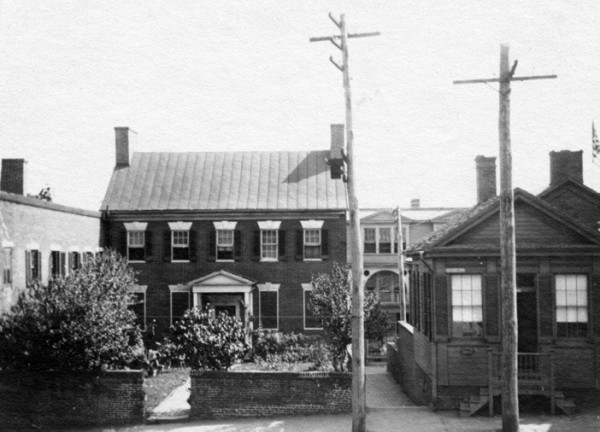
Late-nineteenth-century photograph showing Washington Tuck’s house on State House Circle, Annapolis, Maryland, 1820–1821. (Courtesy, Maryland State Archives, Special Collections, George Forbes Collection.)
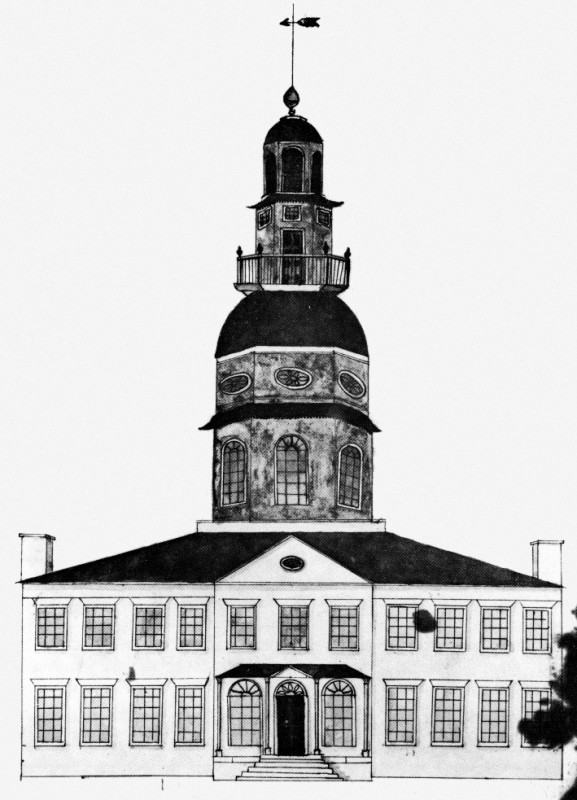
G. W. Smith, The State House at Annapolis, Maryland, ca. 1810, illustrated in Morris Radoff, The State House at Annapolis (Annapolis: Hall of Records Commission of the State of Maryland, 1972), p. 32. This image shows the State House as it probably appeared soon after the completion of the Tucks’ 1807 commission.
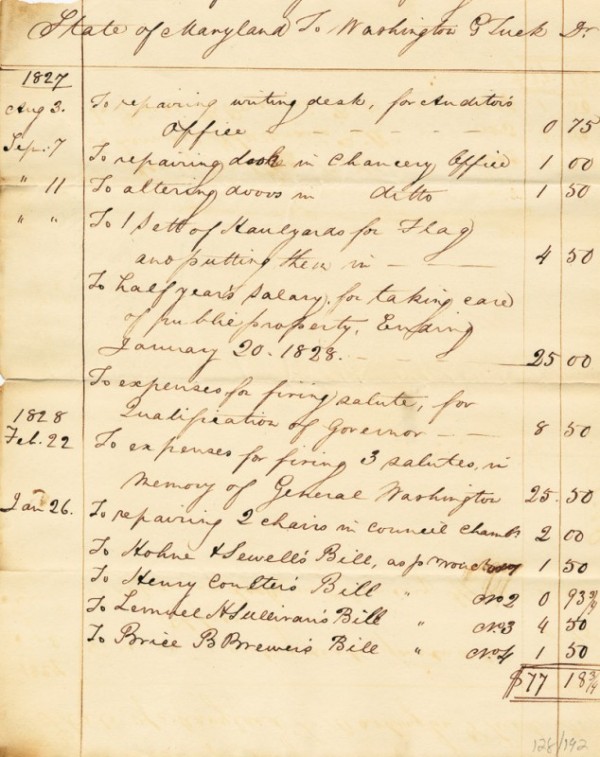
Invoice submitted by Washington G. Tuck to the state of Maryland, 1828. (Courtesy, Maryland State Archives, Maryland State Papers.) Washington Tuck submitted this invoice for a range of services he performed between August 3, 1827, and February 22, 1828. While Tuck commonly repaired furniture in the State House (he received three separate payments for repairing “writing desks,” desks, and chairs during this six-month period), he also completed maintenance projects such as “altering doors” and replacing the halyards for the flag on the dome. The inclusion of payments for “taking care of the public property” and for firing celebratory salutes—a requirement of the state armorer—is common in these invoices, as are the payments to Tuck on behalf of four contractors.
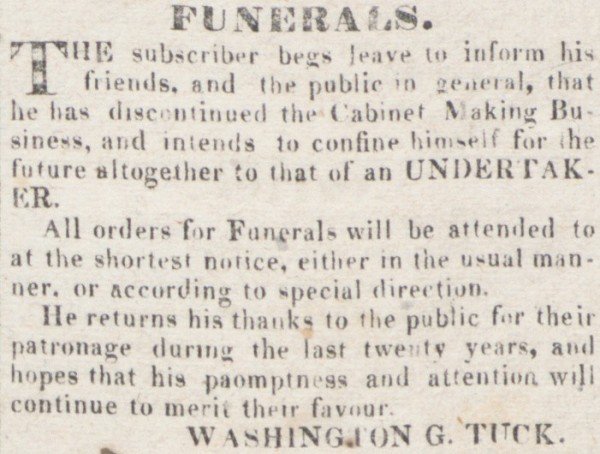
Advertisement by Washington G. Tuck in the Maryland Gazette, June 12, 1834. (Courtesy, Maryland State Archives.)

E. E. Zerlantz, Annapolis, Capitol of the State of Maryland, 1838. Photograph of an engraving. 6 5/8" x 9 1/4". (Courtesy, Maryland State Archives, Special Collections, George Forbes Collection.) This engraving shows the State House (center) as it appeared when Washington Tuck retired from public service. Romantic views of Annapolis were common throughout this period, although it is clear that little of the city’s landscape had changed since the end of the Revolution.
Studies of eastern Maryland furniture have traditionally focused on either eighteenth-century Annapolis or nineteenth-century Baltimore. As the colonial capital and older of the two cities, Annapolis enjoyed a golden age in the years before the Revolutionary War. During the 1760s and 1770s merchants, professionals, and political leaders including James Brice, Edward Lloyd IV, and William Paca built imposing houses (fig. 1), commissioned expensive furnishings, and had their portraits painted by such notable artists as Charles Willson Peale. Although Annapolis continued to serve as the capital after the Revolution, Baltimore quickly became the state’s economic and social center. With its deep-water port, Baltimore was ideally suited for receiving, marketing, and exporting grain from Maryland’s vast hinterland as well as from southern Pennsylvania. The city’s population and the wealth of many of its inhabitants grew geometrically and attracted numerous artisans trained both locally and abroad. By the beginning of the nineteenth century, Baltimore supported more than thirty cabinetmakers, twelve chair makers, and a variety of specialists serving the furniture-making trades. Because of the diversity of that city’s craft community and its surviving products, scholars and students of Maryland furniture have devoted little attention to post-Revolutionary Annapolis work. The sole exception is John Shaw (1745–1829), the city’s most celebrated cabinetmaker, whose shop produced a significant body of stylistically distinctive work, much of it identified by labels (fig. 2). His life and work have been the subject of articles, museum catalogues, and a 1983 monograph titled John Shaw: Cabinetmaker of Annapolis.[1]
The quantity and variety of objects documented to Shaw’s shop have allowed scholars to draw basic conclusions about the forms and aesthetic preferences of Annapolis patrons during the last quarter of the eighteenth century. Conversely, furniture historians have identified only a small number of early-nineteenth-century objects with Annapolis provenances. Much of this later work has been relegated to footnotes or simplistically characterized as products of the “John Shaw School,” thus perpetuating the myth that he was the city’s only successful cabinetmaker. Similarly, little is known about late-eighteenth- and early-nineteenth-century Annapolis artisans in general or the challenges they faced as wealth, private patronage, and economic power shifted from that city to Baltimore. This essay will begin redressing that problem by examining the careers, furniture, and historical contexts of brothers William and Washington Tuck and the influence of public patronage on the cabinetmaking community in early national Annapolis.[2]
Among the most important building projects undertaken in pre-Revolutionary Annapolis were various iterations of the Maryland State House. The third State House, erected on the site of its predecessors, was the largest and most elaborate government building in the city (figs. 3-6). It was built between 1772 and 1779 under the direction of Annapolis merchant Charles Wallace from plans drafted by local architect Joseph Horatio Anderson. Since opening for the start of the 1779 session of the general assembly, the State House has been the most significant political, social, and economic symbol of Annapolis. Most notably, the building served as the capitol of the United States for the meeting of the Continental Congress between November 27, 1783, and August 13, 1784. During this session, General George Washington resigned his commission as commander in chief of the Continental Army on December 23, 1783, and the Treaty of Paris was ratified on January 14, 1784. Construction of its wooden dome, the oldest and largest in America, began in 1788 under the direction of Annapolis architect Joseph Clark and was completed in 1795 under the supervision of John Shaw. Until the beginning of the twentieth century, the State House was home to all three branches of Maryland’s government.[3]
Throughout the eighteenth and nineteenth centuries, the vitality of the city’s economy and the success of its tradesmen and merchants were inextricably linked to the State House. Annapolis artisans found employment there during periods of construction and when maintenance or furnishings were required. Tavern keepers, boardinghouse owners, and local shopkeepers—together making up a quarter of the city’s population in the 1783 tax assessment—derived much of their income when the legislature was in annual session, during the semiannual meetings of the court of appeals and the General Court of the Western Shore, and from the steady influx of students to St. John’s College. Maryland State Archivist Edward C. Papenfuse noted that in 1786 nearly 20 percent of the heads of households in Annapolis had positions affiliated with the government—a figure that diminished little in the decades that followed. These findings suggest that the building itself provided opportunities for those who could parlay their talents to meet the needs of the public sphere. As was the case in most closely knit trade communities in early America, Annapolis tradesmen gained access to town projects through political connections and social and family relationships.[4]
William and Washington Tuck’s entrée was facilitated by the political and social connections of their father, William (ca. 1741–1797), an independent painter-glazier since 1762. During the Revolutionary War and early national period, William supplemented his income by working for the state government. During the 1780s and 1790s he probably spent considerable time developing relationships with important Annapolitans to help his children in their careers. William’s efforts to forge ties between his sons and John Shaw support this assumption. By the time the younger William began working as a journeyman, Shaw had worked in Annapolis for more than thirty years and developed a thriving trade based on broad regional patronage. The Tuck brothers used their master’s and their father’s connections to advance their careers, becoming two of the most respected and successful artisans in Annapolis.[5]
As part of a second generation of cabinetmakers trained in Shaw’s shop, the Tucks understood the intricacies of private and public patronage and recognized the importance of the State House as a potential source of income. Like their master, William (ca. 1774–1813) and Washington (1781–1859) relied on governmental work when private commissions waned during the economic decline following the Revolutionary War. For three decades, the brothers received regular commissions to provide services and furnishings for the Maryland State House and were the only individuals, besides Shaw, consistently entrusted with the care and upkeep of that building between 1807 and 1838. During their careers, the Tucks, primarily Washington, built more than twenty-five pieces of furniture for the State House and commissioned and oversaw the construction and delivery of more than one hundred additional objects. By extending the literature beyond John Shaw, the stories of William and Washington Tuck allow scholars to examine the centrality of the State House in supporting local craftsmen and reveal how two artisans pursued their trade and maintained their competency in early national Annapolis.[6]
The Golden Age of Annapolis
The Annapolis of William and Washington Tuck was significantly altered from the town that had been Maryland’s most important city until the start of the Revolutionary War. From 1763 until the declaration of war in 1776, Annapolis enjoyed a golden age, the city’s most significant period of sustained economic growth and building. An influx of money generated from bountiful harvests, thriving tobacco export markets, and a rising demand for high-quality consumer goods helped establish the power of the colony’s landed gentry in town. Annapolis became the primary port for Maryland’s national and international trade, and its population swelled by 27.7 percent between 1765 and 1775 as many wealthy landowners moved to the leading city in the colony.[7]
Scottish immigrants John Shaw and Archibald Chisholm (d. 1810) were among those who came to Annapolis in the early 1760s in search of employment as journeymen cabinetmakers. Although no apprenticeship documents for either man are known, it is likely that they trained in Scotland rather than in England. Case pieces bearing Shaw’s label show a closer affinity to comparable forms from Edinburgh and other Scottish cities than to those produced in London. Like most immigrant artisans, Shaw and Chisholm modified their stylistic and structural vocabulary to accommodate local design preferences. By 1772 the two Scots had banded together to form the largest shop in the city and established their reputations as leading cabinetmakers in Annapolis. Catering to middle-level and elite patrons, Shaw and Chisholm advertised more than any other contemporary Annapolis cabinetmaker, offered the widest range of services, and even collaborated with other local artisans on selected pieces. In addition to making and repairing furniture, Shaw and Chisholm trained apprentices, imported and sold British furnishings, and provided additional services to the public sphere, suggesting their roles as both artisans and entrepreneurs.[8]
The outbreak of the Revolutionary War significantly altered the economic and demographic landscape of Annapolis; more than a quarter of the capital’s wealthiest residents, including many British loyalists, fled or were forced to leave their lands. Tobacco prices soared when the British blockade of the Chesapeake Bay in 1777 and 1778 curtailed overseas trade. The blockade and the city’s mobilization for an anticipated British invasion brought activity in the port to a standstill and forced residents to focus on sustaining the colony’s war effort. For the first time in more than two decades, merchants and mechanics in Annapolis saw sales to the private sector decline.[9]
Even as the citizens of Annapolis managed the wartime demands for stores and equipment, the center of Maryland’s trade market shifted to Baltimore (fig. 7). With deeper and more accessible ports and access to a vast hinterland, Baltimore became the fastest-growing city in America during the war. By the end of the conflict, Baltimore had captured the market for national and international trade once dominated by Annapolis merchants. In 1789 Annapolis storekeeper David Geddes reported: “I have no news to give you from this place, everything being at a stand. I in my store don’t receive more than from two to three dollars per day. Annapolis is diminishing fast . . . Citizens leaving it every day!” Faced with declining demands for their services, cabinetmakers and other artisans left Annapolis in search of opportunities elsewhere, a trend that signaled the end of the capital’s hold on the furniture-making trade. Even the most skilled craftsmen could no longer depend on private patronage alone to sustain their businesses.[10]
Patronage from state government played a critical role in the preservation of the artisan community that remained in Annapolis after the Revolutionary War. Artisans profited from the established custom for awarding contracts, which placed greater emphasis on political loyalty than the lowest bid. In contrast to modern state contracts, the governor’s council—the state’s executive body—and the general assembly did not always appropriate funds before the start of a project. Money for work at the State House sometimes came as a direct appropriation by the general assembly, but in other instances the council simply appropriated a sum it deemed appropriate. Then, guided by a long-standing tradition of patronage and social connections, the council selected its preferred contractor to undertake or superintend the work.[11]
Even though there were many more craftsmen in Baltimore than in Annapolis, accounting records and executive and legislative proceedings demonstrate that until the mid-1830s the council consistently awarded most State House commissions to artisans in Annapolis. This suggests that government officials were loyal to local craftsmen and may have recognized that the city’s artisan community would collapse without public patronage. Not surprisingly, cabinetmakers and other specialists worked diligently to establish connections to influential members of the government to gain access to work.[12]
To take advantage of the state’s patronage, craftsmen had to broaden their economic and financial outlets beyond the traditional scope of their trades. John Shaw provides one of the most visible examples of an artisan who expanded his range of skills to maximize employment opportunities. During the 1770s and early 1780s Shaw derived most of his income from private commissions and the sale of stock-in-trade. After the war, he compensated for the decline in that aspect of his business by securing public contracts, particularly those associated with the State House. Shaw served as the state armorer, a position he first received during the war, and by the 1790s he was caretaker of the State House, supervising or performing all of the necessary maintenance and renovations to the building, its furnishings, and grounds. During Shaw’s tenure, most of the furniture provided for the building came from his shop and was most likely built by the apprentices and journeymen cabinetmakers working for him.[13]
Documentary evidence and labeled furniture indicate that William Tuck worked in Shaw’s shop from 1795 to 1797 and that his younger brother, Washington, served his apprenticeship there from 1798 to 1801. Several factors may have influenced the Tuck family’s decision to ally with Shaw. The cabinetmaker was undoubtedly acquainted with the elder William Tuck and may have been kin. Perhaps more important, Shaw owned the largest cabinet shop in town when William began his career as a journeyman and Washington came of age. Shaw purchased property across the street from the State House in 1784, and his shop was situated on the same lot (fig. 8). Located between Church (now Main) Street, the hub of the city’s mechanic community, and the State House, Shaw’s shop was ideally situated for the pursuit of private and public commissions.[14]
The Tuck brothers joined Shaw’s shop during its busiest and most productive period—1790–1804. During this fourteen-year span, the workforce reached its peak and included journeymen. It is unclear whether William Tuck learned his trade from Shaw or from another Annapolis furniture maker, such as the latter’s former partner Archibald Chisholm, who retired in 1794.
William’s and Washington’s presence in Shaw’s shop is confirmed by six labeled pieces of furniture made between 1795 and 1797. William inscribed his initials and a date on five Shaw labels, and Washington signed the label of a desk made circa 1797 for the senate chamber in the State House. Although Shaw employed what is presumed to be a large body of workmen in his shop, the Tucks’ initials represent two of eight sets of initials found on labeled Shaw pieces.[15]
Because most of the furniture with initialed labels is typical of Shaw’s standard repertoire, it is likely that journeymen and apprentices were involved in the production of these objects. Like other artisans in the shop, the Tucks undoubtedly worked from designs and patterns created by their master. Since objects from Shaw’s shop were made in a regulated environment, it is difficult to attribute specific structural features and decorative elements to a particular hand. Some surviving objects, however, are superior in design and construction to other Shaw furniture, suggesting that they were commissioned by an important patron and may have required the attention of the most skilled journeymen if not the master himself.[16]
The Tucks and other select journeymen inscribed their initials on the shop labels to attest to their prominent roles in the construction of these pieces, even though they were sold as products of Shaw’s shop. This privileged group must have been highly skilled and trusted, because it is unlikely that Shaw would have let a worker initial a label unless the workmanship reflected positively on the owner of the shop. The prominent placement of Shaw’s labels made it too risky for a worker surreptitiously to initial a piece as a way of showcasing his role in its construction. Even though they primarily worked on stock items, the journeymen who signed these labels exercised some autonomy and pride in their work, and probably used this opportunity to lay a foundation for future commissions and business associations they could pursue after leaving the shop.[17]
Furniture documented to the Tucks resembles undocumented work likely produced by them during their tenure in Shaw’s shop. Collectively, these objects indicate that the brothers were familiar with a broad range of designs and construction methods codified in their master’s shop as well as generic neoclassical motifs seen in late-eighteenth-century Maryland furniture. The scarcity of pieces that can be definitively attributed to Annapolis after 1804 makes it difficult to assess the Tucks’ legacy, but evidence suggests that their training left them well equipped to respond to the exigencies of the working environment in Annapolis during the early national period.[18]
Furniture by the Tuck Brothers
Identification of furniture made by the Tucks is complicated by several factors. First, most of the objects documented to William Tuck were made when he was a journeyman in Shaw’s shop, and it is likely that both William and his brother continued producing furniture similar to their master’s after establishing themselves as independent artisans. Second, no daybooks, account books, ledgers, or other documents survive to identify specific work by the Tucks or other journeymen and apprentices in Shaw’s shop. Finally, given Shaw’s prominence, it is likely that many of his competitors emulated his work. In the absence of strong circumstantial evidence, attributions to Shaw, the Tucks, or other artisans who worked in the former’s shop can be problematic.
Documents related to the State House provide general information about the types of furnishings the Tucks made for the council and the legislature as well as the materials used, but few of these records are descriptive and many simply indicate payment for services rendered. The paucity of surviving State House furniture further complicates attributions. Only one of the more than twenty-five objects built by the brothers for the State House has survived, probably because this furniture was in continuous use over a long time. In addition, some of these objects were given as partial payment to contractors, sold at public auction, or simply discarded. Furniture made by the Tucks for the house of delegates in 1807, for example, was not completely replaced until 1858, at which point the stylistically outdated and damaged pieces (with the exception of the speaker’s desk) were probably donated to the clerk of the school commissioners for Anne Arundel County, Maryland, transferred to the court of appeals chamber, sold as scrap, or even discarded.[19]
One of the earliest objects documented to William Tuck is a mahogany cellaret he made in Shaw’s shop in 1795 (figs. 9, 10). Shaw’s label is glued to the center of the underside of the lid and inscribed “W 1795 T”. At least five similar cellarets from this period have survived (fig. 11), suggesting the use of established proportional systems and patterns. All of these examples have an inlaid false front and a hinged lid that opens to reveal a removable caddy and an undivided section for drinking glasses (fig. 10). In The Cabinet-Maker and Upholsterer’s Guide (1794), George Hepplewhite noted that “CELLERETS, CALLED also gardes de vin, are generally made of mahogany . . . the inner part is divided with partitions . . . may be made of any shape.”[20]
A clothespress inscribed by William Tuck (figs. 12-14) is one of at least three closely related examples made in Shaw’s shop between 1795 and 1797 (figs. 15, 18). Like the aforementioned cellarets documented and attributed to Shaw’s shop, these presses were standardized forms, ideal for the deployment of journeyman labor. The clothespress illustrated in figure 15 is virtually identical to the example inscribed by Tuck, but its label bears the date 1795 and the initials of another journeyman (fig. 16), possibly John Walter Battee (b. 1775). Like the Tuck example, the presses shown in figures 15 and 18 have straight bracket feet with stack-laminated glue blocks (figs. 14, 17, 19). Further examination may reveal that some elements of these presses are interchangeable, much like certain components of desk-and-bookcases designed in Shaw’s shop during this period. For both forms Shaw offered options including flat and scrolled pediments and various inlays (figs. 18, 20).[21]
In contrast, a demilune card table with a label inscribed “W 1796 T” is the only circular example from Shaw’s shop (figs. 21-23). Most of Shaw’s surviving card tables are rectangular, and all are more restrained in the use of neoclassical inlay. While Tuck’s table is something of a stylistic anomaly, it has several features found on other examples from Shaw’s shop: bulbous spade feet; a broadcloth playing surface; a central alignment tenon on the folding leaf and a corresponding mortise on the stationary leaf below; and no medial brace. Similarities between the design of the demilune card table and contemporary Baltimore forms may indicate that Tuck made the former object to replace or accompany an existing Baltimore table owned by one of his master’s patrons. Shaw must have been familiar with prevailing Baltimore styles since he routinely purchased inlays from specialists in that city, as did many of his contemporaries working in eastern Pennsylvania and Maryland, the Shenandoah Valley, and as far west as Kentucky and Tennessee. That was clearly the case with the demilune card table’s sawtooth edging and eagle inlays, which have precise parallels in late-eighteenth- and early-nineteenth-century Baltimore furniture.[22]
The construction of the demilune table suggests that William Tuck and his fellow workmen were unaccustomed to making that form. The rear legs have exposed pins and through-tenons—details not visible on rectangular card tables from Shaw’s shop—and the fly rail hinge and dovetails are less precise than normal (fig. 24). Visible joinery is also atypical of urban neoclassical work in general, making it unlikely that Tuck copied these aberrant structural features from a Baltimore card table.
Unlike demilune tables, desks and secretaries were standard repertoire for Shaw’s workforce. Most of the surviving examples represent private commissions, but his shop also produced similar forms described as “bookcase and desk,” “desk & bookcase,” or simply “cases” for rooms in the State House, including the chambers of the legislature, council, court of appeals, and other offices. Invoices submitted by Shaw to the state of Maryland for work completed during 1816 and 1817 listed two bookcases for the council chamber, including one “with 4 doors pidgeon holes & Shelves” for which he charged thirty-five dollars. Shaw also supplied two presses for the State House during that period. The most expensive example, made for the court of appeals and priced at forty-five dollars, had six doors and “pidgeon holes & shelves with locks & hinges &c.”[23]
“Desk and bookcases, bureaus, wardrobes, [and] secretaries” were among the “ready-made . . . articles of household furniture” listed in Shaw’s advertisement in the October 10, 1803, issue of the Maryland Gazette. Some surviving examples are in the neat and plain style, whereas others have scrolled pediments with elaborate fret-sawn tympana, pictorial inlays, and other decorative features (see figs. 27, 28). Much of the case furniture documented and attributed to Shaw’s shop has stylistic antecedents in Scottish work and resembles, in a general way, objects produced by contemporary Caledonian cabinetmakers working in the colonies and new republic. Although we may never know whether Shaw immigrated with patterns and shop drawings in hand, he clearly used them from the outset of his American career. William Voss Elder and Lu Bartlett, for example, noted that the drawers from a desk-and-bookcase of circa 1780 are interchangeable with those in later examples from Shaw’s shop. Patterns regulated production and allowed multiple artisans to produce components for the same object. A bureau with secretary drawer bearing Shaw’s label and the ink inscription “J 1796 B” (figs. 25, 26) has interior drawers constructed by two different artisans, yet the design of its writing compartment differs little from those on other desks and secretaries from his shop, including those documented and attributed to William Tuck (figs. 27-30).[24]
Although standardization increased the speed and efficiency of Shaw’s workforce, it did not mean that his journeymen were locked into a single mode of production. The shop clearly offered a variety of options for every form. Desks and double-case writing forms were available with straight bracket, ogee bracket (fig. 27), splayed bracket (figs. 29, 30) or French feet; plain or scrolled pediments; fret-sawn or sawn and carved tympana (fig. 31); cornice molding with Gothic arches and acorn drops; and a variety of inlays including shells for fallboards (fig. 32) and friezes, eagles for prospect doors (fig. 33), paterae for cornices, quarter-fans for doors, and stringing for drawer fronts.
A labeled desk-and-bookcase (figs. 29, 34) and secretary-and-bookcase (fig. 30) attributed to William Tuck suggest that he was capable of responding to the most demanding commissions. Family tradition maintained that the original owner of the desk-and-bookcase was Annapolis lumber merchant John Randall, a prominent member of the community who sold wood to Shaw and owned other examples of the cabinetmaker’s work. Like the clothespress illustrated in figures 12 and 13, the desk-and-bookcase and secretary-and-bookcase have drawers with finely cut dovetails, upper cases with four-panel backs, and stack-laminated glue blocks supporting the feet (figs. 35, 36). The fallboard of the desk-and-bookcase also has a central alignment tenon like the upper leaf of the card table associated with Tuck (fig. 24). This feature also occurs on other desks associated with Shaw’s shop. Despite having different design features, the desk-and-bookcase and the secretary-and-bookcase may have been made only a few months, or even weeks, apart. Both objects have swelled bracket feet (fig. 37) like those on contemporary urban case furniture from England and Scotland.
Comparison of the labeled desk-and-bookcase and secretary-and-bookcase attributed to William Tuck (figs. 29, 30) with the two related examples illustrates the problem of separating the work of Shaw’s journeymen without inscribed labels or other documentation. The labeled desk-and-bookcase and secretary-and-bookcase both have stack-laminated foot blocks whereas the pieces illustrated in figures 27 and 28 have single-piece vertical glue blocks. However, as the labeled press shown in figures 15–17 indicates, other Shaw journeymen also used stack-laminated blocks. The upper cases of the secretary-and-bookcase and labeled desk-and-bookcase also have four-panel backs with pinking on the inside surface. The desk-and-bookcase illustrated in figure 27 shares that feature, but the example shown in figure 29 has a two-panel back. There are even variations in the furniture associated with Tuck. The lower case of the secretary-and-bookcase has horizontal backboards nailed into rabbets at the top and sides, whereas all of the desk-and-bookcases illustrated here have vertical backboards attached in a similar manner (figs. 27–29). It is unlikely that any of the major case pieces produced in Shaw’s shop during the mid- to late 1790s represent the work of a single craftsman.
William Tuck was still employed by Shaw when the latter received his most important commission for furniture for the State House. In 1797 the general assembly appointed Shaw to supply “24 Mahogany arm chairs [fig. 2], 10 Mahogany desks for the use of the Senate, and 1 neat Mahogany do for the president,” for which the cabinetmaker received £217.18.6 (fig. 38). The desks illustrate the local preference for furniture built in the neat and plain style, as the pieces are well constructed but without elaborate ornamentation. The president’s desk, which is labeled and inscribed “W 1797 T,” is larger and more ornate than the ten identical examples made for the senators (figs. 39-41). Tuck’s initials confirm the involvement of Shaw’s journeymen in the production of furniture for both the private and public markets.[25]
William Tuck probably left Shaw’s employ in 1797, soon after completion of the senate commission, and by 1799 had formed a partnership with Annapolis cabinetmaker James Lusby. William became an independent shop owner in October 1801 after he and Lusby dissolved their partnership “by mutual consent,” and Tuck advertised his “cabinet business” in the Maryland Gazette. William built and repaired furniture for local residents and was one of the few Annapolis cabinetmakers other than Shaw and Chisholm to receive the patronage of Edward Lloyd V of Wye House. Tuck provided significant amounts of furniture for the Lloyds between 1803 and 1809, a series of commissions undoubtedly related to his association with Shaw, the favored Annapolis cabinetmaker of the Lloyd family at the start of the nineteenth century.[26]
Less than a year after his brother left Shaw’s shop, Washington Tuck began a three-year apprenticeship with the master cabinetmaker on August 16, 1798. Like his older brother, Washington was involved in public and private commissions, including the production of stock-in-trade and furnishings for the State House. The only documented work associated with the younger Tuck’s apprenticeship is a senate desk of circa 1797 that he signed and dated “Wash Tuck 1801” when the piece was in Shaw’s shop for repairs (figs. 42, 43). In urban shops, the repair of damaged furniture was often assigned to apprentices.[27]
Like several of his fellow apprentices, Tuck moved to Baltimore after completing his term with Shaw. By the time he arrived in 1802, Baltimore was the fastest-growing city in the country; its population doubled between 1790 and 1800, and nearly doubled again in the following decade. Washington may have begun his Baltimore career as a journeyman in the shop of cabinetmaker Edward Priestley, whom furniture historian Alexandra A. Kirtley has described as having a business relationship with Shaw by virtue of the two artisans’ connections to the Lloyd family. Her research suggests that Edward Lloyd V may have encouraged Shaw to send his former apprentices to work with Priestley. Such an arrangement would have helped alleviate competition in Annapolis and given Shaw’s apprentices the opportunity to hone their skills making furniture in the latest styles and to learn more about management and marketing by observing Priestley’s interaction with his workforce and his patrons. Washington would also have been exposed to the work of other cabinetmakers, since more than fifty shop masters were active in the city by 1800. Evidence suggests that Tuck was acquainted with several important tradesmen including cabinetmaker William Camp and city dock owner Hugh McElderry. Camp employed former Priestley workman John Needles, and all three cabinetmakers had patrons at the highest levels of society.[28]
When Washington Tuck returned to Annapolis in the fall of 1806, he found an economic environment disturbingly similar to the one he left behind four years earlier. The only consistent source of work remained that connected to the State House and state government. Middle-level artisans like the Tucks had to take advantage of all available outlets for work, even those that stood outside the traditional boundaries of their trades. With their connections to other tradesmen and to such important politicians as Lloyd, William and Washington were ideally positioned to solicit and receive public commissions. Their situation improved even further when Shaw retired as superintendent of the State House in 1807.[29]
The House of Delegates Chamber, 1807
In 1807 the Maryland General Assembly decided to refurnish the house of delegates chamber (fig. 44) and replace the delegates’ furniture—possibly the furnishings supplied for the opening of the new chamber in 1779. On January 3 the Maryland House of Delegates passed a bill ordering the governor and council to “furnish the house of delegates with twenty-one convenient writing desks, with four separate drawers each, for use of the delegation from each county, and the delegation from the city of Annapolis and Baltimore.” Two months later, the council issued a resolution regarding work in the house chamber:
Ordered that William Tuck be employed to do the workmanship, in carrying the designs of the legislature into effect, as related to the fitting up and repairing the house of delegates room: That the room be laid off in circular form, and that the desks be raised one above the other as nearly like the room occupied by congress as may be practicable: That the said house of delegates room be furnished with a new carpet and completed by the time of the meeting of the legislature: That James Lusby and Robert Davis be employed to fit up the senate chamber, by repairing the desks and chairs now out of repair, and make as many new ones as may be necessary to complete the number of fifteen, and that the said senate chamber be provided with a new carpet.[30]
Passage of this resolution coincided with Shaw’s two-year hiatus from state work, and the governor and council had to select other artisans to complete the renovations. The council’s decision to choose two Annapolis cabinetmaking firms to complete the renovations in the State House—even though it would have been cheaper to use Baltimore makers—probably reflected loyalty to local craftsmen rather than concern over quality control. The council did not solicit proposals, although they may have consulted with Shaw in light of his former role as superintendent and his familiarity with local workers.
The Tucks formed an official partnership soon after William received the State House commission, although the elder Tuck later explained that he and his brother had “contracted their partnership back to about . . . [January 1, 1807], in consequence of other work done by them.” Before beginning the State House renovations, William, possibly accompanied by Washington, traveled to the District of Columbia to “take a plan of the finishing of the house of representatives” in the Capitol. William returned to Annapolis to replicate Benjamin Henry Latrobe’s design on a smaller scale, a significant challenge because of the discrepancy in size and shape between the Maryland House of Delegates chamber and the U.S. Capitol’s House of Representatives’ chamber (figs. 44, 45). The brothers also faced the stipulation that all renovations be finished by the start of the legislative session on November 3, 1807. This was a daunting task that entailed providing new furnishings for eighty delegates and two clerks, plastering and painting the room, and supplying a new carpet and window blinds.[31]
The brothers’ final bill detailed the furniture they supplied for completion of the house of delegates chamber and demonstrated the range of their cabinetmaking and entrepreneurial skills. As part of their work for the house of delegates, the Tucks made twenty-four pieces of furniture: nine circular (bow-front) desks valued at ninety dollars each; twelve straight desks valued at fifty-five dollars each; one speaker’s desk valued at fifty dollars; and two clerks’ desks valued at thirty-five dollars each. Designed to the specifications outlined by the general assembly, the delegate desks had four drawers, one for the use of each county delegation. In the absence of surviving examples, it is impossible to determine the dimensions of these desks; however, the circular ones were probably made in three different sizes because of the tiered configuration of the delegates chamber. The Tucks also repaired some of the existing furniture in that room. They charged fifteen dollars for repairing the clerk’s chair, seven dollars for stuffing, repairing, and cleaning the speaker’s chair made by Shaw’s shop in 1797, and one dollar for work on the stool that accompanied the speaker’s chair.[32]
Additional receipts submitted in conjunction with the State House commission suggest that the Tucks traveled to Baltimore to subcontract the chair making and to procure inkstands and sandboxes. The brothers billed the state of Maryland $160 for “80 chairs at 24 dollars per dozen,” $11.12 for “freight on ditto,” and $24.50 for “expenses on [the] chairs.” The low cost of the chairs (two dollars each) suggests that they were Windsors, seating furniture made in large quantities in Baltimore and used in the galleries in the house and senate chambers.[33]
The only known object surviving from the Tucks’ house of delegates commission is the speaker’s desk (figs. 46-49). Although formerly attributed to Shaw on the basis of its construction and style—especially the relation of its inlaid eagle to the one on the desk Shaw’s shop made in 1797 for the president of the senate (fig. 39)—the speaker’s desk is undoubtedly a product of William and Washington’s shop. It is specified on their bill, and Shaw was no longer superintendent of the State House when the Tucks began providing furnishings for the delegates chamber. The fact that the speaker’s desk resembles the senate president’s desk should come as no surprise, given the fact that William worked in Shaw’s shop and Washington trained there.[34]
The speaker’s desk also has features that depart from Shaw’s work. With their lunetted corners and contrasting stringing and banding, the tablets inlaid on the upper leg stiles have parallels in contemporary Baltimore furniture. The Tucks also used satinwood banding on the lower edge of the rails (fig. 48) instead of the applied cock-bead associated with their former master and other local artisans. Likewise, the wooden knobs on the speaker’s desk are a detail rarely, if ever, seen in Annapolis furniture (fig. 49). While there was a clear hierarchy in the furnishings of the house of delegates chamber, with the speaker’s desk situated on the raised dais at the front of the chamber, all of the remaining examples furnished by the Tucks had similar knobs and banding. This was essential not only for a unified furnishing scheme but also to signify equality among the delegates. Regrettably, most of these features are too generic to assist in the identification of other work by the Tucks.[35]
In its final design, the house of delegates chamber was a modification of the House of Representatives chamber in the United States Capitol. The Tucks replicated the furnishing scheme of Congress Hall and the House of Representatives chamber, where groups of straight desks were placed to the immediate right and left of the speaker’s dais and curved desks faced the front of the chamber (fig. 50). For the purposes of their bill, the brothers considered one desk to be “the space allowed for four members to sit at”; thus twenty-one desks accommodated the eighty members of the lower house. The lids were covered in broadcloth, and all of the desks were “separated by small pieces of mahogany between the cloth [and] screwed together” to create individual work spaces for each of the delegates.[36]
The general assembly’s decision to model the house of delegates after the house chamber in Washington was both significant and symbolic. Maryland legislators understood that national unity required a symbiotic relationship between state and federal governments and they sought to express that connection in material form. Henry-Russell Hitchcock and William Seale have argued that regional preferences influenced the design and furnishing of state capitols built before 1824, and that efforts to express nationalism architecturally were minimal. Although built more than two decades before the completion of the U.S. Capitol, the Maryland State House may have been the first to emulate the Capitol in the decoration and aesthetic appearance of one of its rooms. The Tucks incorporated the general assembly’s vision into a design that stressed the idea of unity at national, state, and local levels.[37]
Cabinetmaking in Early National Annapolis
The Tucks finished the renovations in the house of delegates chamber in early December 1807, but the governor and council considered their final bill of $2,988.86 (which did not include a $300.00 advance paid to William in May 1807) too high and refused to remit payment. This billing dispute was undoubtedly fueled by the fact that William did not submit an estimate nor did the council appropriate a sum of money for the work. William later recalled not “having produced to the Council any bills or vouchers for particular charges . . . nor was it required of him.” For many months, it appeared that the council would renege on its promise to go to arbitration if a billing dispute arose. Three months after submitting his bill, William composed a scathing letter to the council, writing, “I am not asking a favour, but asking for my own money; money that you unjustly detain; money that I boldly say, I have honestly and fairly laboured for, money that . . . I am entitled to.”[38]
William and Washington found themselves embroiled in a major political controversy in the eight months between the completion of the work and their receipt of payment. The Tucks received final payment on August 17, 1808, and William proclaimed, “that in his life he was never more surprised . . . for from the previous conduct of the executive it was what he least expected . . . [for] he thought it impossible that they could now pass his account with propriety for the full amount.” A contemporary newspaper account of this saga chronicled the sudden culmination of the billing dispute and noted that “Without a word . . . or any new information to alter their opinion, the council sent an order to the Tucks for the full amount of their claim to the great surprise of William Tuck.”[39]
Despite the anticlimactic resolution of the dispute, the political ramifications warranted the appointment of a house of delegates committee on November 8, 1808—the first day of that year’s legislative session—to
inquire into the expenses in the execution by the governor and council of a resolve . . . authorising them to furnish the house of delegates with twenty-one desks; and that the said committee report to this house the different sums of money advanced under the direction of the executive . . . and to whom, and at what time, and under what circumstances, the same were paid; and that said committee have the power to send for persons, papers, and records.
The committee’s final report, published in the journal of the proceedings of the November 1808 session of the house of delegates as well as in several Maryland newspapers, revealed important information regarding the Tucks’ role within the social and political spheres of Annapolis, as well as the uncertainty of cabinetmaking in the state capital. Witness testimony recorded in the report chronicled the heated political rhetoric between the brothers and members of the council and revealed that, in the end, the brothers secured payment primarily because of their political influence and repeated threats to upset the existing political balance in the house of delegates and the council.[40]
While the Tucks used their position to challenge older political hierarchies, the council sought to preserve its power as the state’s executive body, a branch that refused to be bound by an arbitrator’s ruling. Both brothers considered themselves “ill-treated” by the council, and Washington added that refusal to pay would “injure the republican cause.” The brothers sought the election of a new candidate—not the council’s choice—for the Annapolis seat in the lower house in the upcoming election. A staunch Republican, Washington declared that he would “oppose the council, or the party . . . [and] the impression made by [him] . . . was that in elections for delegates (in which the members of the council, residents in [Annapolis] generally take a very decided and active part) [the members of the council] should never have his vote or influence.” Washington reportedly told many influential Annapolitans that he would “oppose the council in their election unless his account was paid.”[41]
William and Washington’s involvement in city and state politics was significant in Annapolis, a town where members of the governor’s council influenced legislators and even local elections. The Tucks’ conflict with the council took on added significance in an election year, because they “were men likely to be active and of some influence in the city election, where every vote is a matter of consequence.” The eight-month billing dispute was risky for the brothers because they purchased materials from several members of the council as well as the city government, and it did not behoove them to alienate their suppliers or their clientele. An adverse result could have tarnished their standing among council members and removed them from consideration for future government commissions.[42]
The 1808 hearings not only reflected the charged political atmosphere in Annapolis but also illuminated the challenges that faced cabinetmakers working in the city. By the time the Tucks received their commission, Annapolis had ceased to be an important port, and most building and woodworking materials arrived in Baltimore. With no trade associations or guilds to help reduce costs through collective purchases and bargaining, Annapolis cabinetmakers were unable to secure materials as advantageously as their Baltimore counterparts. In his testimony to the house committee, Annapolis merchant and delegate John Muir recalled a statement by Washington Tuck:
Certain cabinet-makers in Baltimore had associated for the purpose of purchasing quantities of mahogany as they arrived; that they, of course, secured for themselves the prime of the wood, and disposed of the inferior to other cabinet-makers in Baltimore, or distant workmen, at such advanced prices as often left their own stock at less than nothing in point of cash.
Washington’s connections with Baltimore cabinetmakers and his past experiences as a journeyman in that city gave credence to Muir’s report, although Annapolis craftsmen had little recourse against such practices.[43]
Artisans in Annapolis could not afford to sell their furniture at prices competitive with those of Baltimore makers because their cost of materials was greater and demand was substantially less. In defense of his bill for the house renovations, William Tuck stated that prices for the “sort of work done in the house of delegates room are always about 20 per cent higher in Annapolis than in Baltimore,” and his brother added that “advance charges on the Baltimore prices for cabinetwork in Annapolis are generally from twenty to thirty percent.” William also noted that the “prices charged the . . . [state government] are the same that he would have charged individuals for . . . [identical] work.”[44]
Whereas Baltimore artisans formed trade organizations that ensured them a political voice and access to work, their Annapolis counterparts had to navigate through an older and increasingly unreliable system dependent on personal connections. Public commissions, primarily those related to the State House, provided the steadiest source of income for all mechanics, but such contracts were by no means lucrative. The building and woodworking skills of Shaw and the Tuck brothers made them ideal candidates for State House commissions because they could perform a range of tasks, including painting, repairing furniture and walls, and plastering, and all three men had social and political connections that facilitated their patronage. Despite struggling to receive payment, the Tucks’ successful completion of the State House renovations solidified their reputations as two of the most important and influential cabinetmakers in Annapolis.
After the Tucks dissolved their partnership in 1810, William opened a boardinghouse at the foot of State House Hill to cater to students, travelers, and public servants attending sessions of the court of appeals and annual meetings of the general assembly. At the time of his death in 1813, his household furnishings included two dozen Windsor chairs, one walnut and one mahogany “bureau and Book case,” a “stained beaufat,” a walnut sideboard, and a “mahogany bottle case.” The adjacent listing of “lot of lumber broken furniture &c.,” a “tea square,” an oval walnut table, eleven low post beds, seven field beds, and a “walnut work table” suggests that William may have continued making and repairing furniture. As was the case with most artisans, he probably made furniture for his own use.[45]
Washington Tuck found employment as state armorer in 1810, a position that he shared with Shaw until the latter’s retirement in 1819. Washington’s primary duties included cleaning and varnishing scabbards, supplying weapons and ammunition to the state armory and military units, and organizing the armory and gun house. Tuck’s government job provided him with a dependable quarterly or semiannual salary—a luxury not afforded to most artisans in the private market—which allowed him to pursue other opportunities, such as supplementing his income by repairing furniture for local residents. He also purchased property (fig. 51) next to Shaw’s house and shop, thereby aligning himself with the man charged with maintenance of the State House. Washington opened his own shop in 1814 and succeeded Shaw as superintendent in 1820.[46]
To Superintend the Necessary Repairs
Washington Tuck served as superintendent of the State House (fig. 52) from 1820 to 1829 and regularly received orders from the council and legislature for work at the capitol between 1830 and 1838. In that capacity, he made recommendations for structural and aesthetic repairs, performed and supervised maintenance and refurnishing projects, and supplied furniture as needed. His role as caretaker of the city’s most prominent symbol of democracy and prosperity boosted Washington’s status at a time when residual effects from the panic of 1819 caused the most successful artisans to struggle. Even after Tuck ceased being superintendent, he received more contracts for work at the State House than any other Annapolis artisan during this eighteen-year period.[47]
In addition to his salary for “taking care of the public property,” Tuck received lump sums of money for his commission and to compensate him for his time, supplies, and the wages he paid to others involved in renovation projects. Time and fiscal constraints were important considerations in all of Washington’s work, since certain projects, like the house of delegates renovations, had to be completed before the start of a legislative or judicial session. Tuck and his predecessor probably worked under budgetary restrictions that determined whether they made furnishings themselves or procured them from Baltimore artisans. Even when funds were not appropriated in advance, Tuck, like Shaw before him, had to make savvy financial decisions to remain accountable to his patrons in the legislature and the governor’s council.[48] In 1826 the governor and council ordered Washington to:
Super-intend the necessary repairs to stop and prevent a leak in the Roof of the State House, and the purchasing of such Desks, Tables, Chairs and other furniture as may be necessary for the Chamber now occupied by the Court of Appeals—provided that the whole amount of said expenditures shall not exceed four hundred dollars.
Tuck received $400 in June 1826, but six months later the council paid him an additional $90.72 for “making a Large double Desk for the Court of Appeals Room and putting partitions in ditto, repairing lock in old Armoury and for Lead putting down around fireplaces in the State House, and for two fire fenders.” Tuck may have procured the desks, tables, and chairs specified in the governor and council’s initial order in Baltimore; however, his final account revealed that those purchases were more costly than anticipated. Governor Joseph Kent reported that Tuck’s “expenditures exceeded the appropriation by the sum of $81.39, although he procured such articles of furniture only, as were deemed essential to the decent and comfortable fitting up of the chamber.” The council subsequently determined that Tuck did not incur any “improper or unnecessary expense” and recommended that the general assembly pay the balance.[49]
The period in which Tuck worked as the superintendent of the State House fell between major renovation campaigns at the public building, and new furnishings were often ordered to replace or complement existing objects. Tuck often made utilitarian objects to fit the needs of the various offices in the building. In February 1822 he received $325.66 “on account for a Book case for the Council Room, packing up and delivering Arms and so forth.” Tuck made a clock for the senate chamber in 1823, a case “to hold the books of records of chancery papers” for the chancery office in 1827, and a mahogany ruler for the chancery office in 1828. He also built several voting and record boxes for the general assembly, court of appeals, and register of wills, and made regular repairs to the desks and chairs in the house of delegates and court of appeals chambers. In 1829 Washington received five dollars for a case for the court of appeals, five dollars for a hat rack for the chancery court, and twenty-five dollars for boxes for the laws and proceedings.[50]
As was the case with John Shaw, Washington’s public work was diverse but usually more mundane than artistic (fig. 53). During his tenure as superintendent, Tuck repaired doors and windows, did painting and plastering, replaced locks and shelves, built a woodshed for the treasury building, set up the state library, and provided carpets for the chambers of the house of delegates and court of appeals. He also supervised landscaping projects including the replacement of stone steps on the west side of State House Circle and repairs made to the “shingling of the circle wall.”[51]
Washington received his last commission at the State House in 1837, when the governor and council appointed him and Richard W. Gill, clerk of the Court of Appeals of the Western Shore, to superintend “repairs, improvements and furniture in several parts of the State House . . . to carry into execution the purposes of the General Assembly.” The two men supervised the painting of the dome and the painting and furnishing of the chambers of the court of appeals, the chancery, and the house of delegates, and the house committee room. Although Tuck purchased most of the new furniture from Baltimore cabinetmakers, he oversaw the construction of the “desk of the tribunal” and the clerk’s desk for the court of appeals, both of which were designed by Baltimore architect Robert Cary Long and made by Annapolis cabinetmaker Elijah Wells. In his contract, Wells noted that the work was “to be done in the best most modern and improved style” and according “to the satisfaction of said Tuck,” alluding to Washington’s expertise as a cabinetmaker familiar with the needs of the building.[52]
Washington Tuck’s Private Commissions
The stagnant economic conditions in Annapolis meant that Washington Tuck was unable to make cabinetmaking his primary trade and may explain why no apprentices or journeymen are known to have worked for him. Tuck did, however, receive commissions from wealthy patrons. He performed a number of services for Edward Lloyd V between 1819 and 1826, a period when the Lloyd family purchased most of their furniture from Baltimore artisans. Tuck also maintained his contacts with Edward Priestley and appears in the deceased cabinetmaker’s list of debts in 1837.[53]
On June 12, 1834, Tuck placed his only advertisement in the Maryland Gazette (fig. 54), reporting that he had “discontinued the Cabinet Making Business” and intended “to confine himself for the future . . . to that of an UNDERTAKER.” Tuck thanked “the public for their patronage during the last twenty years” and expressed hope that “his promptness and attention” would “continue to merit their favour.” Like many of his contemporaries, Tuck understood that the social and political connections he developed as a cabinetmaker could be exploited in this trade. In August 1828 Tuck received $75.37 1/2 for arranging the funeral of Harriet Callahan Ridgely, whose husband, John, was a prominent doctor. Her “raized top coffin, lined and shrouded with cambrick, cords, tassels & pillows, covered with super fine Black cloth,” accounted for fifty dollars of Tuck’s fee.[54]
As the experiences of William and Washington Tuck suggest, artisans in early-nineteenth-century Annapolis had to be resourceful and flexible to adapt to their town’s economic and demographic decline as well as competition from Baltimore merchants and tradesmen. The greatest threat to economic stability came in 1817 and 1818, when the Maryland General Assembly considered relocating the capital to Baltimore. The legislature rejected the idea even though Baltimore’s city government had pledged to finance the construction of all necessary public buildings. According to nineteenth-century historian Elihu S. Riley, the “strongest point made against . . . [moving the capital] was the mob in Baltimore [during the War of] 1812.” Riley’s statement suggests that the legislature considered Annapolis the safer of the two cities, owing to its smaller population and geographic location. Not until the constitutional reforms of 1836–1838 did Baltimore artisans gain regular access to contracts for work at the State House and Government House—the residence of Maryland’s governors.[55]
To some early historians, Annapolis in the 1820s and 1830s appeared much as it had at the start of the century: quiet and undisturbed by the changes happening elsewhere in the rapidly developing nation (fig. 55). A nineteenth-century writer contended that “[Annapolis] should be called the pivot city . . . for while all the world around it revolves it remains stationary. . . . To get to Annapolis you have but to cultivate a colossal calmness and the force of gravity will draw you . . . there.” In reality, this romantic description overstates the conditions in the Maryland capital. To the outside observer, Annapolis became a provincial outpost with little economic activity after the Revolution; however, the city’s role as a political center ensured employment for artisans who could adapt to the demands of the public sphere. William and Washington Tuck’s decision to design furniture for the State House and to shift their business from providing furniture for private patrons to fulfilling government contracts for a variety of work was a necessary response to the challenges facing Annapolis artisans, especially cabinetmakers, in the early national period. In an era marked by diminished employment opportunities, the Tuck brothers remained in their hometown and committed themselves to helping the city’s artisan community survive an era of economic decline.[56]
ACKNOWLEDGMENTS
For assistance with the article, the author thanks Elaine Rice Bachmann, Luke Beckerdite, Mimi Calver, Stiles T. Colwill, Jeannine Disviscour, Alexandra A. Kirtley, Robert Leath, Dr. Christine Arnold-Lourie, Lisa Mason-Chaney, Melissa Naulin, Dr. Edward C. Papenfuse, Sumpter T. Priddy, Gerald W. R. Ward, and Gregory R. Weidman.
William Voss Elder III and Lu Bartlett, John Shaw: Cabinetmaker of Annapolis (Baltimore: Baltimore Museum of Art, 1983). For more on artisans and merchants active during the age of affluence in Annapolis, see Edward C. Papenfuse, In Pursuit of Profit: The Annapolis Merchants in the Era of the American Revolution, 1763–1805 (Baltimore: Johns Hopkins University Press, 1975); The Diary of William Faris: The Daily Life of an Annapolis Silversmith, edited by Mark B. Letzer and Jean B. Russo (Baltimore: The Press at the Maryland Historical Society, 2003); and Mark P. Leone, The Archaeology of Liberty in an American Capital: Excavations in Annapolis (Berkeley: University of California Press, 2005).
Most scholarly publications on Annapolis-made furniture focus on John Shaw and virtually exclude the work of his contemporaries (W. M. Horner Jr., “John Shaw of the Great Days of Annapolis,” International Studio 98, no. 406 [March 1931]: 44–47, 80; Louise E. Magruder, “John Shaw, Cabinetmaker of Annapolis,” Maryland Historical Magazine 42, no. 1 [March 1947]: 35–40; Rosamond Randall Beirne and Eleanor Pinkerton Stewart, “John Shaw Cabinetmaker,” Antiques 78, no. 6 [December 1960]: 554–58; and Lu Bartlett, “John Shaw, Cabinetmaker of Annapolis,” Antiques 61, no. 2 [February 1977]: 362–77; Elder and Bartlett, John Shaw: Cabinetmaker of Annapolis).
Since 2000 the Maryland State Archives and Maryland Historical Trust have been engaged in a comprehensive examination of the history of the State House as part of the research relating to the compilation of a Historic Structure Report (hereafter cited as HSR) for the capitol. Documents uncovered during the initial research phases of the HSR provided the genesis for this study. On its completion, the HSR will become the definitive record of the Maryland State House, and all of the relevant materials will be made accessible online through http://mdstatehouse.net, an interactive website containing all of the documents and images pertaining to the building and grounds from 1769 to the present. The website is part of the Archives of Maryland Online publications series (Special Collections, Maryland State House History Project, msa sc 5287). Former Maryland State Archivist Morris L. Radoff published the only books dedicated to the history of the State House, but both were limited to the architectural history of the building (Morris L. Radoff, Buildings of the State of Maryland at Annapolis [Annapolis: Hall of Records Commission of the State of Maryland, 1954]; and Morris L. Radoff, The State House at Annapolis [Annapolis: Hall of Records Commission of the State of Maryland, 1972], p. 30).
Newspaper advertisements indicate that tradesmen outside Annapolis traveled to the capital to take advantage of economic opportunities related to the legislative and judicial sessions. Mrs. Ann Merriken of Baltimore advertised in the December 11, 1817, Maryland Gazette that she had taken up lodging in the house “formerly occupied by Mr. Washington G. Tuck & directly opposite the State house, where she has on hand, and intends keeping during the legislature, an elegant assortment of Millinery, a large variety of fancy goods of the latest fashion . . . baskets, gloves.” She also noted that “those that wish any thing in her line will find it to their advantage to give her a call, and especially Gentlemen of the legislature that would wish to give their Wives and Daughters A CHRISTMAS GIFT.” Papenfuse, In Pursuit of Profit, p. 137.
The elder William Tuck served as doorkeeper and clerk for the Maryland Council of Safety in 1776 and was appointed messenger of the Maryland Senate in 1778, a post he held intermittently into the 1790s. In 1795 his namesake begin working in Shaw’s shop, and his other son, Washington, matriculated in the Grammar School and the School of Humanity or Languages at prestigious St. John’s College. Significantly, the matriculation book noted that Washington Tuck, “Son of Wm Tuck. Painter & Glazier. Annapolis: adopted by the Senate of Maryland. Pr Wm Cooke, Esq.,” was to attend school part-time “tuition gratis” (St. John’s College, Archives, St. John’s Matriculation Book, 1795, fol. 10, MSA SC 5698-2-1). As a middling artisan, the elder Tuck could not have afforded to send his youngest son to St. John’s, and the senate scholarship was extended as a way of recognizing the former’s contributions to that body since the 1770s and to ensure his younger son had a path to success in spite of the family’s economic status. The elder William’s debt list indicates that he was acquainted with some of the city’s most influential citizens including tavern keeper George Washington Mann, cabinetmakers John Shaw and Archibald Chisholm, and former governors George Plater and William Paca (a signer of the Declaration of Independence) (Anne Arundel County Register of Wills, Testamentary Papers, MdHR 4767-35-5, MSA C 149-40).
Daniel Vickers, “Competency and Competition: Economic Culture in Early America,” William and Mary Quarterly, 3rd ser., 47, no. 1 (January 1990): 7.
For more on the development of elite and gentry homes in Annapolis during the city’s age of affluence, see Architecture in Annapolis: A Field Guide, edited by Marcia M. Miller and Orlando Ridout V (Crownsville: Vernacular Architecture Forum and Maryland Historical Trust Press, 2001). An analysis of population growth in Annapolis between 1699 and 1783 can be found in Papenfuse, In Pursuit of Profit, pp. 14, 29. See also Lois Green Carr and Lorena S. Walsh, “Changing Lifestyles and Consumer Behavior in the Colonial Chesapeake,” in Of Consuming Interests: The Style of Life in the Eighteenth Century, edited by Cary Carson, Ronald Hoffman, and Peter J. Albert (Charlottesville: University of Virginia Press for the United States Capitol Historical Society, 1994), pp. 59–166.
Shaw and Chisholm were in partnership from 1772 to 1776, and again in 1783 after a fire destroyed Shaw’s shop. For more on these partnerships, see Bartlett, “John Shaw, Cabinetmaker of Annapolis,” pp. 362–77; and Joseph Suess, “Archibald Chisholm—an Annapolis Cabinetmaker,” Maryland Genealogical Society Bulletin 31, no. 3 (1990): 223–38. Maryland Gazette, November 14, 1776, and February 6, 1783.
Papenfuse, In Pursuit of Profit, pp. 73–75, 78.
Ibid., pp. 101–25. David Geddes to John White, August 21, 1789, Executive Papers, Box G, Maryland State Archives, as quoted in ibid., p. 156. Between 20 and 26 percent of Annapolis craftsmen, constituting one-fifth the total population, left the city after the war. Although Shaw and Chisholm were the only cabinetmakers listed in the 1783 tax assessment for Annapolis, advertisements in the Maryland Gazette document the presence of several competitors in the city during the late eighteenth century. With the exception of Shaw, the Tuck brothers, Gilbert Middleton, William Ross, and Henry Thompson, most of these cabinetmakers appear to have lived in the capital for only a short time. Some probably worked as journeymen in established shops or left to find work in Baltimore, Georgetown, or the District of Columbia, as William Waters, Henry Lusby, Robert Davis, and William King did. For more on King, see Anne Castrodale Golovin, “William King Jr., Georgetown Furniture Maker,” Antiques 111, no. 5 (May 1977): 1032–37. Papenfuse, In Pursuit of Profit, pp. 156–68.
With a subjective state contract system that lacked a formal bidding process to determine awards, some artisans resorted to lobbying the council. On March 12, 1807, shortly after the general assembly approved the refurnishing of the house of delegates chamber and the repairs to the furniture in the senate chamber, Annapolitan James Houston wrote to Governor Robert Wright on behalf of “Mr. Henry Thompson, Cabinet-Maker of this place [who] wishes to contract for making part of the Furniture which the Executive are authorized to procure.” Houston explained that he “had some work done by Mr. Thompson and found him reasonable in his charges as well as faithful in the execution of his work. . . . I am in hopes he will not be overlooked by the Board when they make the contract.” In this instance, however, Houston’s lobbying effort fell short, as the council selected two other local cabinetmaking firms to complete the renovations specified by the legislature. Maryland State Papers, Series A, MSA S 1004-121, MdHR 6636-90-151.
See Governor and Council Proceedings, MSA S 1071; and Votes and Proceedings of the Maryland Senate and House of Delegates; and MD Laws. One particularly valuable accounting document is the Maryland Public Documents 1837 Report of the Treasurer of the Western Shore, which was dedicated to the “sums which have been expended . . . for repairing and furnishing the Public Buildings and improving the Public Circle” between 1826 and 1838.
Shaw served as the caretaker of the State House for more than thirty years, although he did not have a formal title until 1817, when the governor and council placed him in charge of the preservation of the “State House and all its appendages” and agreed to pay him fifty dollars per year (Governor and Council Proceedings, 1813–1817, fol. 379, MSA S 1071-32). In addition to his quarterly salary, he received commissions for major refurnishing campaigns and miscellaneous maintenance projects. Although Shaw may have lacked a title until the end of his career, he had participated in or supervised most of the State House projects undertaken after the Revolutionary War, including the illumination of the capitol and the construction of a stage for festivities in connection with George Washington’s resignation of his commission on December 23, 1783. See, for example, Maryland State Papers, Scharf Collection, MSA S 1005-11773, MdHR 19,999-077-107.
Three connections between the Tuck, Shaw, and Pratt families of Annapolis suggest an important and previously undocumented familial relationship. In the March 4, 1762, Maryland Gazette, William Tuck Sr. referred to his mother, Sarah, as the “widow Pratt,” indicating she had remarried. Fourteen years later, Gilbert Middleton, John Shaw, and Archibald Chisholm offered a reward for the return of three runaway apprentices, including twenty-year-old Henry Pratt (Maryland Gazette, June 20, 1776). The following year, Shaw married Elizabeth Wellstead Pratt. Henry Pratt, who was presumably born circa 1756, may have been a half brother to William Tuck Sr. and Elizabeth Pratt may have been his half sister. If the Tucks and Shaw were relatives, that would help explain how Tuck’s sons gained access to Annapolis’s most important shop tradition. Genealogical publications and internet postings have cited an undocumented marriage between John Shaw and a woman named “Wealthy Tuck,” but the author has seen no evidence to verify that claim. Moreover, there is no documentation for the death of William Tuck Sr.’s father, the subsequent remarriage of William’s mother, or the death of Sarah Pratt’s second husband. Although members of the Tuck and Pratt families remained in Anne Arundel County through the 1760s, no probate or marriage records for any of these individuals are in the Maryland State Archives. Sarah Pratt’s name does, however, appear in local judicial records until 1768. She may have died circa 1770.
Eight sets of initials have been documented on Shaw labels: “JA,” “JB,” “TB,” “JH,” “HT,” “WT,” “WASH TUCK,” and “J [A] W” (Elder and Bartlett, John Shaw: Cabinetmaker of Annapolis, p. 29). The letters “I” and “J” were still used interchangeably in eighteenth-century English, and without additional evidence it is not possible to determine conclusively which letter was inscribed on the labels. For this reason and for consistency, the relevant initials listed above have all been converted to the letter “J.” Several cabinetmakers with first names beginning with the letter “J,” including John Walter Battee, Jonathan Hutton, and Jonathan Weedon, are known to have worked in Annapolis during this period, and, in the case of Battee and Weedon, trained with Shaw; this does not, however, rule out the possibility that workmen whose names began with the letter “I” also worked for Shaw. The discovery of account books or other records from Shaw’s shop may clarify the initials and link them with the men employed by the master cabinetmaker.
According to Elder and Bartlett, because there was a “large and doubtless constantly changing group of craftsmen working in [Shaw’s] shop at any one time and perhaps more than one man working on each piece of furniture, attempts to correlate details of construction techniques with any set of initials on the labels have proven fruitless” (ibid., p. 29).
Shaw’s journeymen may have placed initials on labeled objects as a means of identifying their work and payment due. In reference to artisans employed by the Seymours, Robert Mussey theorized that “signatures on [the men’s] work probably indicate that they were to be paid as journeymen . . . for their share of the production, typically twenty to twenty-five percent of the final sale price . . . the system of signatures allowed each man to be paid for the work he executed” (Robert D. Mussey Jr., The Furniture Masterworks of John and Thomas Seymour [Salem, Mass.: Peabody Essex Museum, 2003], p. 61).
I refer to pieces that the Tuck brothers “built” or “worked on” with full recognition that they did not necessarily construct each object in its entirety.
The Governor and Council Proceedings document many payments to Washington Tuck, but no receipts or vouchers submitted by the cabinetmaker are included. Accounting records confirm the completion of his work. For example, the proceedings note: “Washington G. Tuck paid $200 for making case for chancery records” on October 15, 1827 (Governor and Council Proceedings, 1825–1830, MSA S 1071-36). The 1858 proceedings of the house of delegates provide some clues regarding removal of the furniture supplied by the Tucks in 1807. The delegates ordered the state librarian to transfer the desks to the clerk of the school commissioners of Anne Arundel County “for use in the Public Schools and Academies of said county,” and ordered that eighteen chairs be appropriated for use in the court of appeals. The remaining chairs were to be transferred to Cambridge Academy in Dorchester County, Maryland (Votes and Proceedings of the House of Delegates of Maryland [hereafter cited as VPHOD], 1858, pp. 35, 60, 134). Attempts to trace or locate these furnishings have proven fruitless because no other surviving records allude to this transfer.
The early provenance, current owner, and location of the cellaret illustrated in figure 9 are not known (Elder and Bartlett, John Shaw: Cabinetmaker of Annapolis, pp. 101–2, no. 32). A 1797 label inscribed with the initials “JH” and affixed to a Shaw sideboard (Baltimore Museum of Art) has been mistakenly associated with the William Tuck cellaret. This stems from confusion created when the label on the sideboard and the cellaret were both published in the Baltimore Museum of Art’s 1968 exhibition catalogue Maryland Queen Anne and Chippendale Furniture of the Eighteenth Century (New York: October House for the Baltimore Museum of Art, 1968). The catalogue entry for the cellaret (pp. 56–57, cat. 38) noted the presence of a label but did not refer to any inscriptions, and the caption for the label (p. 114) did not associate it with a particular piece. Moreover, the 1795 cellaret was the only labeled Shaw piece in the exhibit, and the 1797 label was the only one illustrated in the catalogue. Further confusion regarding the label occurred when Bartlett illustrated the sideboard in “John Shaw, Cabinetmaker of Annapolis,” p. 374, and she erroneously stated that the label was inscribed “W 1797 T.” The 1795 cellaret made by William Tuck was not illustrated in her article. The author thanks William Voss Elder III for information on the cellaret and sideboard. For more on cellarets, see Anne S. McPherson, “Bottle Cases,” Antiques 166, no. 2 (August 2004): 76–83. George Hepplewhite, The Cabinet-Maker and Upholsterer’s Guide (1794; reprint, New York: Dover, 1969), p. 7.
For more on these clothespresses, see Elder and Bartlett, John Shaw: Cabinetmaker of Annapolis, pp. 104–8, 115–18, no. 34 (Hammond-Harwood House), no. 35 (Maryland Historical Society), no. 39 (Baltimore Museum of Art).
Ibid., pp. 111–12, no. 37. The eagles on this table are the most common type found on neoclassical Baltimore furniture. Virtually identical eagles are on three card tables in the Diplomatic Reception Rooms of the United States Department of State (Treasures of State: Fine and Decorative Art in the Diplomatic Reception Rooms of the U.S. Department of State, edited by Alexandra W. Rollins [New York: Harry N. Abrams, 1991], pp. 220–22, nos. 130–32). The author thanks Gregory R. Weidman for this reference. The “flame-like oak leaves” on the rear legs of the Tuck table may also have been produced in Baltimore (Elder and Bartlett, John Shaw: Cabinetmaker of Annapolis, p. 112).
Shaw was not the only local cabinetmaker to supply cases for the offices in the State House. In 1785 Archibald Chisholm received £15.5 for a “bookcase and desk” for the office of the Intendant of the Revenue, and former Shaw apprentice Jonathan Weedon received $17.60, which included a $1.60 commission paid to Shaw, for a case for the council chamber in 1819. Shaw’s 1816 and 1817 invoices also included payments for painting the presses a “mahogany colour.” Maryland State Papers, Series A, MSA S 1004, MdHR 6636-101-96; Maryland State Papers, Series A, MSA S 1004-135, MdHR 6636-100-32; Auditor General, Journal, MSA S 150-5, Peter Force Collection B-2, fol. 444, MSA SC 4391; Governor and Council Orders on Treasury, June 23, 1819, MSA S 1092-2.
Elder and Bartlett, John Shaw: Cabinetmaker of Annapolis, pp. 118–21, no. 40. In their discussion of a similar desk-and-bookcase at the Hammond-Harwood House, the authors noted the lack of depth in the fretwork and suggested that it “could have been produced from a standard template by a journeyman, and did not require the skills of a specialized carver” (p. 140, no. 49).
Treasurer of the Western Shore, Journal of Accounts, 1797, fol. 48, MSA S 606-8. For a detailed discussion of the furniture supplied for the senate in 1797, see Elder and Bartlett, John Shaw: Cabinetmaker of Annapolis, pp. 122–31; see p. 122, no. 41 for the president’s desk. A November 1798 account “for repairs of the Senate Chamber to J. Shaw” lists nineteen artisans and laborers who provided materials and work for the renovations made to the chamber in 1797. Although the account named the local plasterers, carpenters, and others who provided additional building materials, none of the journeymen who helped Shaw construct the furniture for the chamber are named. Rather than submit an account, Shaw probably paid the journeymen out of the appropriation he received from the general assembly or the governor and council (Maryland State Papers, Series A, MSA S 1004-18-22075, MdHR 6636-81-99). Scholars have questioned why Shaw provided only eleven desks—including the one for the president—for the senate in 1797 when there were sixteen senators. It is possible that the 1797 desks matched existing desks from an earlier commission, but the absence of documentation makes this theory highly speculative. Many of the original elements of the president’s desk were altered or removed after the piece was replaced in the chamber sometime between 1838 and 1845, but the front, back (location of Shaw label), and drawer front are original. The inlaid eagle was probably purchased from a Baltimore merchant or specialist. The banding around the eagle appears on other pieces from Shaw’s shop, including a sideboard dated 1797 (Baltimore Museum of Art). This president’s desk descended in the family of Baltimore cabinetmaker John Needles and suffered from being converted into a coffee table. Oral tradition suggests that Needles received this desk—and other furniture provided by Shaw in 1797—as partial payment for work in the senate chamber in the 1830s. The desk was presented to the state of Maryland and restored by Baltimore cabinetmaker Enrico Liberti in 1940, at which time the top, scalloped gallery, legs, and stretchers were replaced.
William Tuck probably left Shaw’s shop in 1797. William’s father died in May of that year, and no pieces bearing his initials have dates later than 1797. Neither William nor Washington was recorded in the 1798 tax assessment for Annapolis, suggesting they may have established residence with another local artisan or possibly rented a house in town. Maryland Gazette, October 15, 1801. Shaw and Chisholm both provided furnishings for the Lloyds’ Annapolis house and for Wye House in Talbot County, Maryland. Alexandra A. Kirtley suggested that the Lloyds favored Chisholm and “only patronized Shaw when he worked on his own after Chisholm retired in 1794.” Receipts at Wye do not specify the type of services that William Tuck provided, but they document substantial patronage of him early in the first decade of the century. Edward Lloyd V paid Tuck more than $140 for furnishings in 1803 (Alexandra A. Alevizatos, “‘Procured of the best and most Fashionable Materials’: The Furniture and Furnishings of the Lloyd Family, 1750–1850” [master’s thesis, University of Delaware, 1999], pp. 207, 383–85, fig. 29). As was often the case in early-nineteenth-century America, Lloyd often settled his debts with goods rather than money. Between 1803 and 1811 Lloyd gave Tuck wood, wheat, and pork valued at $423.19, but paid him only $60.00 in cash. For more on these and other transactions, see Lloyd Papers, ms 2001, reel 25, Manuscripts Department, Maryland Historical Society; Wye House Account Book, 1803–1820, as quoted in Alevizatos, “‘Procured of the best and most Fashionable Materials,’” pp. 217, 33.
Anne Arundel Country Register of Wills, Orphans Court Proceedings, 1798, fol. 31, MSA C 125-8. Elder and Bartlett, John Shaw: Cabinetmaker of Annapolis, pp. 133–34, no. 46. Maryland State Papers, Series A, MSA S 1004-113, MdHR 6636-84-89. The last number inscribed on the label is illegible, and the years 1801, 1804, and 1807 have variously been associated as the date of Tuck’s repair of the piece. The date of the inscription is most likely 1801 because that year coincides with Washington’s documented tenure with Shaw as well as known repairs in the senate chamber that occurred in the same year. Shaw received £97.12 on February 13, 1801, for work that included “putting cloths on the Tables in the Senate and House of Delegates” and repairing the seats in the house chamber. The following year he received £54.18 for additional repairs to the seats in the house (Maryland State Papers, Series A, MSA S 1004-113, MdHR 6636-84-89; Treasurer of the Western Shore, Journal of Accounts, 1788–1802, fol. 34, MSA S 606-3). Shaw received $54.76 on January 7, 1804, for “repairs to the seats and furniture in the State House” (Treasurer of the Western Shore, Journal of Accounts, 1803–1806, fol. 38, MSA S 606-9). This payment may have been related to work done the previous year, a date that does not match the inscription or a time when Tuck is known to have worked with Shaw. Although the desks in the senate were repaired in 1807, the work was executed by James Lusby and Robert Davis and not by either of the Tucks, who were both charged with refurnishing the house. Advertisements in the Maryland Gazette indicate that Shaw sold new, imported, and secondhand furniture throughout the eighteenth century, but he did not use the term “ready made” in any of his advertisements until the early nineteenth century. On October 10, 1803, he announced the sale of “ready made . . . articles of household furniture,” including “desk and book-case, bureaus, wardrobes, secretaries, side boards, dining, breakfast, and card tables, drawing room and easy chairs, sofas, bedsteads of different kinds, bason stands, knife boxes, liquor do.” The term “ready made” suggests that Shaw’s shop was producing furniture for stock-in-trade or that he was operating a wareroom for his own products as well as those of other local cabinetmakers.
Charles G. Steffen, The Mechanics of Baltimore: Workers and Politics in the Age of Revolution, 1763–1812 (Chicago: University of Illinois, 1984), pp. 4–6. Washington’s whereabouts between 1802 and 1806 cannot be confirmed by assessment records or city directories, since he owned no property and the directories rarely listed journeymen. The absence of documentation and the fact that the Tuck brothers did not form a partnership until 1807 suggest that Washington Tuck moved to Baltimore soon after completing his apprenticeship. Washington had returned to Annapolis before October 6, 1806, when he voted for delegates to represent the city in the general assembly (Annapolis Mayor, Alderman and Councilmen Proceedings, Annapolis Records, 12, October 6, 1806, fol. 174, MSA M 47-14). Kirtley first posited the reciprocal agreement between Lloyd and Priestley in Alevizatos, “‘Procured of the best and most Fashionable Materials,’” pp. 219–20. A number of Shaw apprentices, including Henry Lusby, son of William Tuck’s former partner Jacob, moved to Baltimore to continue the trade after completing their apprenticeships. For more on Priestley, see Alexandra Alevizatos Kirtley, “A New Suspect: Baltimore Cabinetmaker Edward Priestley,” in American Furniture, edited by Luke Beckerdite (Hanover, N.H.: University Press of New England for the Chipstone Foundation, 2001), pp. 2–53. In 1808 Washington Tuck requested the assistance of William Camp for an evaluation of the work that the Tuck brothers had done in the house of delegates chamber. Camp, along with Baltimore cabinetmaker Walter Cook, examined the work in the chamber and made a report to the governor and council (VPHOD, 1808 Session, p. 84). It is unlikely that Washington would have asked Camp to look at the renovations on his behalf unless they already had an established professional or social relationship.
It is not known why Shaw stopped working for the state (except as the state armorer), although his decision may be connected to the death of his second wife, Margaret, on July 5, 1806. Shaw reclaimed his position as superintendent in 1808 and held it until 1820, when Washington Tuck took over the duties.
VPHOD, 1806 Session, pp. 93–94. The general assembly had considered a reconceptualization of the lower house chamber in 1798 and ordered that the governor and council authorize a contract for the room to be “formed and fixed in the same manner as in the house of representatives of the United States.” The resolution instructed that the tables and chairs in the house chamber be formed and fixed in the same U-shaped configuration as in Congress Hall in Philadelphia, an arrangement that featured three tiered rows of tables (Governor and Council Proceedings, 1798, fols. 325–26, MSA S 1071-29). That June, the council voted three to two against this bill. Those who voted against it shared “the opinion that the room is too small to have it fitted so as to accommodate the [eighty] members comfortably.” As an alternative, the council employed John Shaw “to measure the room . . . and to produce a plan for the accommodation of the Representatives of said room” (Governor and Council Proceedings, 1807, fols. 427–28, MSA S 1071-30).
William Tuck, quoted in VPHOD, 1808 Session, p. 84. The brothers may have entered into partnership as early as March, but they were certainly working together by June, when Washington purchased more than two pounds worth of lathes and other materials from Annapolis lumber merchants John Randall and Archibald Dobbin on behalf of his brother. Randall and Dobbin’s account book also notes that Washington purchased scantling and plank for Annapolis cabinetmaker John Ross in January 1807, which suggests that he may have worked in another Annapolis shop before partnering with his brother (Randall and Dobbin Account Book, 1798–1807, MS 679, Manuscripts Division, Maryland Historical Society, Baltimore). Work in the house of delegates began “sometime about the month of August 1807” (William Tuck, quoted in VPHOD, 1808 Session, p. 84). In a March 31, 1808, letter to the governor and council, Baltimore cabinetmakers William Camp and Walter Crook indicated that the Tucks’ bill included a charge of fifteen dollars for “their expenses going to Washington to take a plan of the finishing of the house of representatives.” William Camp and Walter Crook, Exhibit No. 7, VPHOD, 1808 Session, p. 93. It is not possible to compare the furniture supplied by the Tucks in 1807 with that from the original House of Representatives because nothing survived the 1814 destruction of the Capitol by the British during the War of 1812. The federal government subsequently commissioned New York cabinetmaker Thomas Constantine to provide new furnishings including straight tables to accommodate 32 members and circular tables to accommodate 160 members. For more on the furnishings of the U.S. House of Representatives chamber, see Margaret B. Klapthor, “Furniture in the Capitol: Desks and Chairs Used in the Chamber of the House of Representatives, 1819–1857,” in Records of the Columbia Historical Society of Washington, D.C., 1969–1970, 69 (Washington, D.C.: Smithsonian Institution, 1971), pp. 190–211. For more on the life and work of Thomas Constantine, see Matthew A. Thurlow’s article in this volume and “Thomas Constantine: Cabinetmaker and Mahogany Merchant in Early Nineteenth-Century New York” (master’s thesis, University of Delaware, 2004).
A transcription of the Tucks’ bill is in VPHOD, 1808 Session, p. 90.
The Tucks were not the first Annapolis artisans to look to Baltimore for assistance with renovations in the State House. A decade earlier, John Shaw received £3.15 for “expenses going to Baltimore for a plasterer” in conjunction with unspecified renovations that may have been in the senate chamber (Maryland State Papers, Series A, MSA S 1004-18, MdHR 6636-15-193E).
The Museum of Fine Arts, Boston has recently acknowledged the author’s case for reattribution of the speaker’s desk (63.12) to William and Washington Tuck. Richard H. Randall Jr., American Furniture in the Museum of Fine Arts, Boston (Boston: Museum of Fine Arts, 1965), pp. 76–79, no. 59; and Elder and Bartlett, John Shaw: Cabinetmaker of Annapolis, pp. 164–65, no. 61.
Invoices submitted in 1837 by Baltimore cabinetmaker James Askey, including a ten-dollar charge for purchasing “knobs for desks in the House of Delegates,” confirm that each of the desks made by the Tucks had wooden knobs (Maryland State Papers, Series A, MSA S 1004-225, MdHR 6636-157-265). There are no known Shaw pieces with original wooden knobs, although some knobs may have been replaced with brass pulls at a later date. Charles Montgomery noted that “mahogany knobs held in place by wood screws came into use” circa 1810 (Charles F. Montgomery, American Furniture: The Federal Period [New York: Viking Press, 1966], p. 51).
The twelve straight desks were situated on either side of the speaker’s dais in three elevated rows. The nine circular desks, also arranged in three tiered rows, were “in one place three and in others two, screwed together,” a reference to the size and number of mahogany dividers on each of the desks in a particular section (William Tuck, quoted in VPHOD, 1808 Session, p. 85).
Henry-Russell Hitchcock and William Seale, Temples of Democracy: The State Capitols of the USA (New York: Harcourt Brace Jovanvich, 1976), p. 53.
William Tuck, quoted in VPHOD, 1808 Session, p. 85. William Tuck in Exhibit No. 4, VPHOD, 1808 Session, p. 92.
Henry H. Harwood, quoting William Tuck, VPHOD, 1808 Session, p. 89. Fredericktown Herald (Frederick, Md.), September 2, 1809, research files, Museum of Early Southern Decorative Arts, Winston-Salem, North Carolina.
VPHOD, 1808 Session, pp. 5–6. This marked the house of delegates’ second attempt to investigate the billing dispute between the Tucks and the council. The house failed to pass an order during the previous session that requested the governor and council to “furnish this house with information of the expense incurred” during the renovations of the house of delegates chamber (VPHOD, 1807 Session, p. 97). Often cited by scholars of Maryland furniture, this report has only been vaguely referenced in the context of the speaker’s desk and its relationship to the State House. Few scholars, if any, have attempted to unravel one of the richest sources of information regarding cabinetmaking and artisanal life in nineteenth-century Maryland. In his history of the Maryland general assembly, Carl N. Everstine, former director of the Department of Legislative Reference, downplayed the report’s significance and found it strange that the journal of the house had devoted “attention to the curious and inconsequential episode involving the Tuck brothers.” Everstine also noted that the “puzzle about the whole affair is why the House of Delegates and its committee felt any obligation to expend their time and energies on a minor political squabble marked chiefly by threats to ‘get even’” (Carl N. Everstine, The General Assembly of Maryland, 1776–1850 [Charlottesville, Va.: Miche Company, 1982], pp. 294–95).
Both brothers testified that they felt “ill-treated” by the council (VPHOD, 1808 Session, pp. 85, 86). James Shaw, quoting Washington Tuck, in ibid., p. 88; Thomas H. Bowie, quoting Washington Tuck, in ibid., p. 87.
Fredericktown Herald, September 2, 1809.
John Muir, quoting Washington Tuck, in VPHOD, 1808 Session, p. 86.
William Tuck, in VPHOD, 1808 Session, p. 84; Washington Tuck, in ibid., p. 86.
No obituary or death notice for Tuck appeared in the Maryland Gazette, but public records suggest that he died between January and March 1813. On January 7, 1813, William appeared in Anne Arundel County Court to mortgage two slaves, thirty pairs of blankets, and six bedsteads to Annapolis resident Joseph Sands (Anne Arundel County Court, Land Records, liber WSG 2, fols. 100–101, MSA C 97-53). In the March 11, 1813, Maryland Gazette, William’s wife, Cave, reported, “she continues the Boarding House lately carried on by her husband.” Tuck’s inventory is especially valuable in revealing the scope of his business because he died in the middle of his career (Anne Arundel County Register of Wills, Administration Accounts, July 28, 1825, liber THH, fols. 471–73, MSA C 29-16).
Washington’s professional relations with Shaw and Edward Lloyd V likely had much to do with Tuck’s appointment as state armorer, especially since he assumed that position only two years after his bitter 1808 struggle with the council. Washington first appeared in the records as state armorer in November 1810, and it is unlikely that he held this title before 1810. Indeed, Shaw received payments from the council in 1808 and 1809 for such duties as “taking care of the military stores” (1808) and “mounting cannon” (1809). In some cases, Shaw and Tuck may have served as armorer concurrently, although Tuck had taken over for his former master by 1820. Records of payments from the council to Tuck for his work as armorer are in the proceedings of the governor and council. (Maryland State Papers, Series A, MSA S 1004-91, MdHR 6636-91-12; Governor and Council Orders on Treasury, March 8, 1809, MSA S 1092; and Governor and Council Proceedings, MSA S 1071). In 1810 Tuck received ten dollars for repairing furniture for Dr. John Ridgely of Annapolis (Special Collections, Ridout Papers, MSA SC 910, Box 30, Folder 3). While Tuck, Shaw, Henry Maynadier, and a few other Annapolis cabinetmakers provided furniture for the Ridgely family, receipts indicate that the Ridgelys, like many of their Annapolis peers, frequently purchased furniture from Baltimore cabinetmakers including William Camp and Hugh and John Finlay (Ridout Papers, Boxes 28, 30, and 31, MSA). The author has not seen any official record of this changing
